Chapter 4: Accessible Routes
Where Required: Site Arrival Points [§206.2.1]
This guide explains scoping and technical requirements for accessible routes in the ADA Standards.
At least one accessible route must be provided within the site to accessible facility entrances from these site arrival points, where provided:
-
accessible parking and accessible passenger loading zones
-
public streets and sidewalks
-
each public transportation stop.
Accessible Routes within a Site [§206.2.2]
At least one accessible route within the boundary of the site originating from site arrival points must connect all accessible buildings, facilities, elements, and spaces on a site.
Accessible Routes (Exterior) within a Site
Accessible Routes within a Building or Facility
At least one accessible route must connect all accessible spaces and elements. If a circulation path is interior, the accessible route also must be interior. Accessible vertical interior circulation must be in the same area as stairs and escalators, not isolated in the back of the facility.
In alterations and additions, an accessible route is required where circulation paths are altered or built (§202.3). Also, alterations or additions to areas containing a primary function (a major activity for which a facility is intended) require an accessible path of travel that extends to site arrival points to the extent that the additional cost does not exceed 20% (§202.4). Otherwise, if a space or element is altered, but the circulation path to it is not, an accessible route is not required.
Where Required: Multi-Story Buildings and Facilities [§206.2.3]
An accessible route must connect each story and mezzanine in a facility unless an exception applies. However, if a building does qualify for an exception in the Standards:
-
all other provisions in the Standards still apply to stories and mezzanines not served by an accessible route
-
elevators provided anyway must fully comply (as standard or LULA elevators)
-
vertical access still may be required by an applicable state or local code.
Private Sector Facilities (Places of Public Accommodation & Commercial Facilities)
An accessible route is not required to connect stories in a private sector facility (place of public accommodation or commercial facility subject to title III of the ADA) that is either less than 3 stories or that has under 3,000 square feet per story and is not a:
-
shopping center or mall with 5 or more sales or rental establishments
-
professional office of a health care provider
-
public transit facility or airport terminal
In mixed use facilities that otherwise qualify for this exception, vertical access is required to any story containing occupancies not permitted the exception.
Public Sector (Government) Facilities
An accessible route between stories is required in multi-story government facilities subject to title II of the ADA except those with no more than two stories where the inaccessible story above (or below) the entry level has no public use space and an occupant load of five maximum.
Exceptions for Specific Occupancies [§206.2.3]
The Standards also include limited exceptions for accessible routes between stories in air traffic control towers and, under certain conditions, detention and correctional facilities, residential facilities, multi-story transient lodging guest rooms, and qualified historic facilities.
Mezzanines (Private and Public Sector Facilities) [§206.2.4, Ex. 3]
An accessible route must serve mezzanines in multi-story facilities where vertical access between stories is required or provided. An accessible route to mezzanines is not required in:
-
single story facilities (mezzanines do not count as a story) or
-
facilities that are exempt from the requirement for an accessible route between stories (additional conditions apply to restaurants and cafeterias).
Alterations and Additions [§206.2.3.1, §202.4]
In alterations and additions to multi-story facilities, an accessible route to stories and mezzanines is required where a stair or escalator is provided where none existed previously and major structural modifications are necessary (§206.2.3.1). The accessible route must connect each level served by the new stair or escalator (except where a compliant connecting accessible route already exists).
An accessible route to stories or mezzanines may be required as part of an accessible path of travel to primary function areas that are altered or added (§202.4). Alterations or additions involving primary function areas must include an accessible path of travel that extends to site arrival points to the extent that the cost is not “disproportionate” (i.e., more than 20% of the total cost of alterations to the primary function area).
Exceptions for accessible routes between stories and to mezzanines permitted in new construction, including those based on the number of stories or square footage per story, apply fully to alterations and additions, including those that trigger an accessible path of travel to a primary function area.
Accessible Routes to Accessible Spaces and Elements [§206.2.4]
An accessible route must connect accessible facility entrances with all accessible spaces and elements in a facility that are connected by a circulation path (§206.2.4). Exceptions for accessible routes to stories and mezzanines (§206.2.3 and §206.2.4, Ex. 3) do not extend to level changes within a story or mezzanine that are part of a required accessible route to spaces or elements. These exceptions apply only to the portions of an accessible route that connect stories or that connect a story and mezzanine.
Dining Areas in Restaurants and Cafeterias
In newly built restaurants and cafeterias, an accessible route must serve all dining areas, including those that are raised or sunken or located outdoors (§206.2.5). If a story or mezzanine is exempt from the requirement for vertical access, an accessible route within each story or mezzanine is still required to connect dining areas and other spaces and elements even though an elevator (or ramp) does not serve the story or mezzanine.
In alterations, an accessible route is not required to existing raised/ sunken dining areas or to all parts of outdoor dining areas if the same services and decor are available in other dining areas that are accessible (§206.2.5, Ex. 2). A platform lift (or limited use-limited application elevator) can be used to provide access to such areas in alterations, but not in new construction (§206.7).
Performance Areas An accessible route must connect stages and other performance areas directly to seating areas where they are directly connected by a circulation path as well as to dressing rooms and other ancillary spaces used by performers (§206.2.6).
Press Boxes [§206.2.7]
An accessible route is required to press boxes except where the aggregate area of all press boxes serving a playing field or assembly area is no more than 500 sq. ft. if press boxes are either:
-
free-standing and elevated above grade at least 12’ or
-
located in bleachers with points of entry on one level.
Free-Standing Press Box
Bleacher-Mounted Press Box
The 500 sq. ft. maximum applies to the gross floor area, including exterior floor space, of all press boxes serving a playing field, stadium, or other assembly area. If a site has multiple assembly areas with press boxes, the aggregate area of press boxes is to be calculated separately for each assembly area.
Employee Work Areas [§206.2.8]
Common use circulation paths must be accessible in employee work areas that are 1,000 sq. ft. or more in size. This applies to the size of work areas as defined by permanently installed walls, partitions, counters, casework, or furnishings, but not modular partitions or furnishings, including systems furniture. Other portions of areas used only by employees for work are not required to comply.
This requirement does not apply to employee work areas that are either less than 1,000 sq. ft. in size or that are exterior and fully exposed to the weather. However, these types of employee work areas still must be accessible for “approach, entry, and exit” (§203.9). This requires a connecting accessible route to the work area, a compliant entrance, including entry doors or gates, and a wheelchair space within the work area. Work areas must also be served by an accessible means of egress, as required by the International Building Code. (See the ADA Scoping: New Construction Guide.)
Recreation Facilities [§206.2.9 – §206.2.17]
The ADA Standards also address accessible routes to amusement rides, boating facilities, bowling lanes, court sports, exercise machines and equipment, fishing piers and platforms, golf and miniature golf facilities, and play areas.
Accessible Routes [§402]
Components of accessible routes include walking surfaces, doorways, ramps, curb ramps, elevators, and, where permitted, platform lifts.
Clearances [§403.5]
The minimum 36” continuous clear width of accessible routes can reduce to 32” at points, such as doorways, for a maximum distance of 24”. Greater clearance is required for 180 degree turns around narrow obstructions and for wheelchair turning space. The minimum clearance cannot be reduced by any elements, including handrails or protruding objects.
180 Turns Around Obstructions
Additional clearance is required at 180 degree turns around an element that is less than 48” wide. The clear width must be at least 48” at the turn and 42” minimum approaching the turn (unless the clear width at the turn is 60” minimum).
Passing Space [§403.5.3]
Passing space is required every 200 feet and must be provided as a 60” by 60” minimum space or as T-shaped space where each stem is at least 48” long.
60” Min. by 60” Min. Passing Space
T-Shaped Passing Space
Handrails Along Walking Surfaces [§403.6, §505]
Handrails are required at ramps with a rise greater than 6” and at stairs that are part of a means of egress, but not at other locations. Where handrails are provided along other portions walking surfaces, they must comply. (Handrails provided in elevator cabs or on platform lifts are not required to comply).
Handrails along Walking Surfaces
-
34” – 38” high measured to the top of the gripping surface.
-
Gripping surface must be continuous the full length and top and sides cannot be obstructed.
-
The bottom gripping surface can be obstructed up to 20% of the length (or along the full entire length when part of crash rails or bumper guards).
-
No sharp or abrasive elements on gripping surfaces or adjacent surfaces, and no rotation within fittings.
Surface requirements and clearances facilitate a power grip along the length of handrails. Handrails can have circular or non-circular cross-sections, but must have rounded edges. The gripping surface and adjacent surfaces must be free of abrasive or sharp elements.
Common Questions
If no pedestrian route onto a site is provided, is an accessible route still required?
An accessible route from the boundary of the site is not required where the only means of site arrival is a vehicular way without pedestrian access. Where vehicular ways are also intended to accommodate pedestrian travel, such as a shopping center parking lot, an accessible route is required.
Do accessible routes that cross vehicular ways need to be marked as a crossing?
No, accessible routes that cross vehicular ways are not required by the Standards to be marked as a crossing. The Standards only require access aisles at accessible parking spaces and accessible passenger loading zones to be marked. (Local codes and traffic laws may require crossings to be marked).
Do stories not required to be on an accessible route have to comply with the Standards?
Yes, stories (and mezzanines) not connected by an accessible route must still meet all other applicable requirements in the Standards. This ensures access for people with disabilities who can use stairs and facilitates compliance should vertical access be achieved through later renovations or additions.
Do basements count in determining a facility’s story count?
As defined in the Standards, a “story” pertains to those portions of buildings “designed for human occupancy included between the upper surface of a floor and upper surface of the floor or roof next above” (§106.5). A basement or other level below grade designed for human occupancy (i.e., equipped with lighting, ventilation, and means of egress) counts as a story. Basements or other levels not containing any space designed for human occupancy are not considered stories under the Standards.
Is an accessible route required to rooftop levels?
In facilities where an accessible route is required to each story (§206.2.3), an accessible route must serve rooftop levels that contain public or common use spaces or elements that are required to be accessible, such as sun decks, lounges, dining areas, bars, or swimming pools. An accessible route is not required to rooftop levels in those facilities that are exempt from the requirement for an accessible route to each story based on the number of stories or the square footage per story. In determining whether a facility qualifies for this exception, rooftop levels are not counted as a story unless they meet the definition of “story.” The Standards define a story as “that portion of a building or facility designed for human occupancy,” (i.e., equipped with lighting, ventilation, and means of egress) that is “included between the upper surface of a floor and upper surface of the floor or roof next above” (§106.5).
Do the exceptions for accessible routes between stories apply to facilities that are only partially occupied by entities not permitted the exception, such as health care facility or shopping center?
Accessible routes between stories are not required in private sector facilities that are either less than 3 stories or that have less than 3,000 square feet per story excluding the professional offices of health care providers, shopping centers and malls with at least 5 sales or rental establishments, and public transit facilities, including airport terminals. In mixed use facilities that otherwise qualify for this exception, an accessible route is required to serve each story containing occupancies not permitted the exception. For example, if all sales or rental establishments of a shopping center are on the same story, an accessible route is required only to that story. If located on multiple stories, an accessible route must connect to each story that contains a sales or rental establishment.
When alterations are made on an upper story of a facility, is vertical access required?
If an alteration includes installation of a stair or escalator where none existed previously and involves major structural modifications, an accessible route between levels served by the stair or escalator is required (unless an accessible route already exists). If alterations are made to a primary function area on an upper floor, an accessible path of travel to the area is required to the extent that the cost is not disproportionate (i.e., more than 20% of the cost of the overall alteration). In any alteration, an accessible route between stories is not required in a facility that qualifies for those exceptions permitted in new construction based on the number of stories or square footage per floor.
When an addition increases the number of stories or square footage beyond the maximum permitted by the exception, is an accessible route between stories required?
If a facility no longer qualifies for the exception for multi-story facilities due to an increase in square footage or stories, an accessible route between stories is required where the work also includes installation of a stair or escalator where none existed previously and major structural modifications are needed (unless a compliant accessible route between stories already exists). The accessible route must connect the levels served by the new stair or escalator. Also, if the addition includes a primary function area, an accessible path of travel to the primary function area is required, including where it involves travel between stories or levels, to the extent the cost does not exceed 20% of the cost of the overall alteration. Compliance in an alteration, including with the requirement for an accessible route between stories, is not required where it is “technically infeasible.” In this case, compliance is required to the maximum extent feasible.
Accessible Entrances: Minimum Number [§206.4]
At least 60% of public entrances must be accessible in new construction, in addition to entrances directly serving tenancies, parking facilities, pedestrian tunnels and elevated walkways. “Public entrances” include all entrances except those that are restricted or that are used exclusively as service entrances.
Public Entrances Required to be Accessible
Recommendation: Access should be provided to a primary entrance for greater usability and convenience (as is required for residential dwelling units).
Entrance Landings
Entrance landings must accommodate door maneuvering clearances as well as landings for provided ramps.
Entrance Landing
Security Barriers [§206.8]
Accessible route adjacent to security screening device
Security bollards and screening devices at accessible entrances cannot obstruct accessible routes or accessible means of egress. Accessible routes can be adjacent to metal detectors and other screening devices that do not accommodate all people with disabilities, but the route must be located so users can maintain an equivalent level of visual contact with personal items.
Restricted Entrances [§206.4.7]
If entrances are restricted to certain occupants on a controlled basis, at least one must comply in addition to public entrances required to be accessible. This applies to those entrances where entry access is verified by security personnel and is strictly limited to certain occupants, but no one else, including guests or companions of authorized individuals. All other types of entrances, excluding service entrances, are considered “public entrances” under the Standards, including employee-only entrances requiring keys or access cards or codes but that lack the level of security of restricted entrances.
Two-Way Communication Systems [§230 and §708]
Where two-way communication systems are provided to gain entry to a facility or to restricted spaces, they must include visual and audible signals to accommodate people with hearing, speech, or visual impairments. This applies to all entrances equipped with such systems, including those that are inaccessible. Lighted signals should have labels to indicate their meaning. If handsets are provided, cords must be at least 29” long. Control buttons and other operable parts must comply at those systems located at accessible entrances.
Alterations [§206.4 and §202.4]
In alterations to existing facilities, accessible entrances are required:
-
if an existing entrance is altered (and no fully compliant entrance already exists);
-
when entrances are newly added to a facility or as part of a facility addition; or
-
as necessary to achieve an accessible path of travel to primary function areas that are altered (unless disproportionate to the cost).
When alterations are made to primary function areas, a connecting accessible path of travel from site arrival points is required to the extent that it does not exceed more than 20% of the project cost. Achieving an accessible entrance should be the top priority in providing the accessible path of travel according to regulations implementing these Standards.
Qualified Historic Facilities
These requirements also apply when alterations are made to qualified historic facilities. However, if making a public entrance accessible would threaten or destroy a facility’s historic significance (as determined by the appropriate State Historic Preservation Official or Advisory Council on Historic Preservation), access can be provided to a non-public entrance instead. A notification or remote monitoring system is required where such an entrance is locked. (§206.4, Ex. 2)
Doors, Doorways and Gates [§206.5 and §404]
Compliance is required for doors, doorways, and gates providing user passage on accessible routes. At least one accessible door, doorway, or gate serving each accessible room, space, and entrance must comply.
Manual Doors and Gates [§404.2]
Clear With [sic] [§404.2.3]
The clear width is measured from the stop to the face of doors or gates open 90⁰ (or to the leading edge of sliding or folding doors. No projection into the clear width is permitted below 34.”
Clear Width and Vertical Clearance of Doors and Gates [§404.2.3]
Maneuvering Clearances [§404.2.4]
Required maneuvering clearances provide space for opening and proceeding through doors, doorways, and gates using wheelchairs and other mobility aids.
Required door clearances provide unobstructed space for maneuvering through doorways.
Maneuvering clearances must be free of protrusions the full height (80” min.) and changes in level (other than thresholds).
Maneuvering clearances are specified according to direction of approach, swing of doors, and in some cases the presence of a closer or latch. They are required on both sides of doors or gates except at those that can be used in one direction only.
Clearance beyond the latch side is not required at entry doors to hospital patient rooms. Such doors are usually wider to accommodate beds and gurneys, and they are often located close to adjacent interior walls to facilitate circulation and to enhance privacy.
Recessed Doors and Gates [§404.2.4.3]
Thick walls, casework, shelving, columns and other elements can cause doors or gates to be recessed. If any obstruction within 18” of the latch side projects more than 8” from the face of a door or gate, maneuvering clearances for a forward approach must be provided. This space must be inset at obstructions so that it is no more than 8” from the face of the door or gate.
Walls and other obstructions can offset the maneuvering clearance up to 8” from the face of the door.
At deeper recesses, the maneuvering clearance must be sized for a forward approach and located 8” maximum from the face of the door.
Thresholds [§404.2.5]
The height of thresholds is limited to 1/2” in new construction. The edge must be beveled 1:2 maximum above a height of 1/4”. A maximum height of 3/4” is permitted for existing or altered thresholds if they have a beveled edge on each side with a slope not steeper than 1:2. These requirements apply to all types of doors required to comply, including sliding doors.
Threshold Profile
Doors and Gates in Series [§404.2.6]
At hinged or pivoted doors or gates in series, a separation is required that is at least 48” plus the width of doors or gates swinging into the space. This allows users to clear one door or gate before opening the next and applies to those doors or gates that are opposite each other where travel through both doors is required.
Recommendation: Wheelchair space 30” min. by 48” min. beyond the swing of a door in other configurations, such as vestibules with doors on adjacent walls, will provide room to clear one door before opening the next.
Door and Gate Hardware [§404.2.7]
Door and gate hardware must:
-
allow one-hand operation
-
not require tight grasping, pinching, or twisting of the wrist
-
operate with 5 lbf maximum
-
be located 34” to 48” above the floor or ground.
Hardware that can be operated with a loose grip or closed fist, such as lever-shaped handles and U-shaped pulls, accommodates the greatest range of users. (Closed-fist operation, while advisable, is not mandated by the Standards). Round door knobs do not comply because they require twisting of the wrist.
Latches and locks with small parts that must be manipulated can be difficult to use and will not comply if pinching is necessary. However, keys and access cards that are not part of the lockset are not required to comply (but those that do not require pinching or turning provide better access). Hardware that does not require simultaneous actions are better, but some types, such as handles with thumb latches are acceptable.
Recommendations:
-
Specify hardware that is usable with a closed fist of loose grip
-
Bars, pulls, and similar hardware should provide sufficient knuckle clearance (1½” minimum) to facilitate gripping
-
Avoid hardware that requires hand or finger dexterity, fine motor movement, or simultaneous actions.
Opening Force [§404.2.9]
The maximum 5 lbf opening force applies to all accessible doors and gates except:
-
fire doors (minimum opening force allowed by code)
-
exterior hinged doors (no maximum specified)
-
latch bolts and other devices that keep doors or gates closed
The 5 lbf maximum applies to the continuous application of force necessary to fully open a door, not the initial force needed to overcome the door’s seal resulting from unequal pressure. Latch bolts must be retracted and other devices that keep doors or gates closed must be disengaged prior to measuring the opening force. (Such devices, like other door and gate hardware, must operate with a maximum 5 lbf force (§404.2.7), but their operating force is not included in the measure of door or gate opening force). Door pressure gauges and other products are available to measure the opening force.
Measuring Door or Gate Opening Force with Pressure Gauge
When using door gauges and other measuring devices, it is advisable to follow these steps (except where product instructions specify otherwise):
-
Open the door so that the face edge aligns with the door frame outside edge
-
Place gauge immediately above door operating hardware about 2½” from the latch edge of the door (approximately the centerline of the door hardware)
-
Push slowly keeping the pressure gauge perpendicular to the face of the door
-
Remove the pressure gauge when the door is open 70 degrees.
Opening Force of Exterior Doors
The opening force of exterior swing doors is impacted by wind loading and other exterior conditions, gasketing, HVAC systems, energy efficiency, and the weight of doors. The minimum force needed to ensure proper closure and positive latch usually exceeds the accessible limit of 5 pounds of force (lbf) required at other doors. For this reason, a maximum opening force is not specified for exterior hinged doors.
Recommendation: Automation of exterior doors is recommended, especially where the opening force is likely to be significant. Otherwise, closers should be calibrated with the least force necessary for closure to minimize the opening force. Difficulty opening manual entrance doors is a common access complaint.
Door and Gate Surfaces [§404.2.10]
The bottom surface of doors and gates on the push side must be smooth to a height of at least 10”. This facilitates access since mobility aids, including wheelchair footrests, are sometimes used to push or prop open doors. Kick plates can be used to help protect door surfaces, but any gaps or cavities between the kick plate and the door surface must be closed or capped. Horizontal or vertical joints in this surface cannot exceed a 1/16” variation in plane.
These requirements do not apply to:
-
Sliding doors
-
Doors and gates that do not extend to within 10” of the finish floor or ground
-
Existing doors or gates with kick plates (so long as cavities created by kick plates are capped)
-
Tempered glass doors without stiles if the top edge of the bottom rail or shoe is tapered at least 60⁰ from the horizontal.
Communication Access at Doors [§806.3.2, §806.3.2]
ETA Editor's Note
This section title contains a typo, as it duplicates section number "806.3.2." On the Access Board's website, however, the second "806.3.2" is actually hyperlinked to the correct section, 809.5.5, regarding primary entrances in residential dwelling units.
In addition to requirements for two-way communication systems provided at restricted entrances, the Standards include requirements for communication access in transient lodging and residential facilities:
-
visible signals for door bells or knocks are required in transient lodging guest rooms providing communication access (§806.3.2);
-
a hard-wired doorbell with visible signals is required at the primary entrance in dwelling units providing communication access, along with a means to visually identify visitors without opening the door, such as a vision panel or peephole (§809.5.5).
Recommendation: Peepholes and other means of identifying visitors in mobility accessible guest rooms and dwelling units are not addressed by the Standards. Products are available with prisms and optical lenses that do not require a close approach and can be easily used from standing and seated postures. They are more effective than locating a regular peephole at a lower height which can impact visual identification of visitors.
Doors and Gates Operated Only By Security Personnel [§404.1, Ex]
Manual doors, doorways, and gates that are designed to be operated only by security personnel, such as guards in a jail or prison, are exempt from requirements for hardware, closing speed, and opening force, but must meet all other requirements, including those for maneuvering clearance. This exception applies only where security personnel have sole control of doors or gates. If automated, such doors or gates are required to comply only with provisions for clear width and thresholds, as well as applicable provisions of the referenced ANSI/BHMA Standards.
Automatic and Power-Assisted Doors and Gates [§404.3]
Doors are not required to be automated, but must comply when provided. The Standards apply industry Standards developed under protocols of the American National Standards Institute (ANSI) and published by the Builders Hardware Manufacturers Association (BHMA). The ANSI/BHMA Standards address operating characteristics, including opening speed, safety features, sensors and activation devices, and labeling, among others. Doors are classified by their type or level of automation.
Power-Assisted Doors and Gates [§404.3]
Power-assisted devices reduce the opening force of doors with closing mechanisms.
They are activated by initial manual force, switches, or sensors. Most reduce, but do not fully eliminate, the manual force needed to open a door. For this reason, they must meet maneuvering clearance requirements.
Power-Assisted Door
Low Energy Doors and Gates [§404.3]
Low energy doors and gates usually require activation by the user through a push plate or control and are often used in moderate traffic locations as an alternative to manual operation. Most function like a manual type but with a powered opener and closer option.
Automated Door (Low Energy)
Controls [§404.3.5]
Door and gate controls must be compliant as operable parts (operable with one hand and without tight grasping, pinching, twisting of the wrist, or more than 5 lbf). Clear floor space at controls must be located outside the door swing to prevent users from getting hit by the door.
Clear floor space at door control must be located outside door swing.
Recommendation: Placing controls in locations that preclude backing-up will facilitate usability. The clear floor space is not required to be centered at controls, but should be located to facilitate reach and operation.
Full-Powered Automatic Doors and Gates [§404.3]
Full-powered automatic doors and gates are often found in grocery and retail stores, hotels, and airports to ease passage with shopping carts or luggage. Most are automatically activated by mats or overhead sensors and do not require manual activation by users.
Automated Door (Full-Powered)
Common Questions
Must a primary entrance be accessible?
The Standards require that primary entrances to dwelling units be accessible. It is advisable, though not required, that access be provided to the primary entrances of other types of facilities.
Is there a maximum travel distance to entrances from parking and other site arrival points?
No, the Standards do not limit the travel distance to accessible entrances. Accessible parking spaces must be located on the shortest accessible route to an accessible entrance (relative to other spaces in the parking facility). A quantitative travel distance between entrances and site arrival points is not specified. In addition, accessible routes must coincide with, or be located in the same area as, general circulation paths.
Is automation of doors required?
Automation of doors is not required by the Standards, but it is highly recommended for entrance doors where the opening force is significant. A maximum opening force is not specified for exterior hinged doors because of the closing force typically necessary for ensuring positive latch against wind loading, air pressure, and other conditions. This often results in opening forces well above the 5 lbf maximum. Difficulty opening exterior swing doors is a common complaint. Automation offers the best solution. Otherwise, closers should be set with the minimum force practicable.
Do requirements for “public entrances” apply only to those entrances used by the public?
No, scoping provisions for accessible public entrances are not limited to those used by the public. The term “public entrance” applies to all entrances other than service or restricted entrances. “Restricted entrances” are those available for common use (but not public use) on a controlled basis. This is intended to apply specifically to entrances where user identity is verified and entry is strictly limited to certain occupants, but no one else, including guests or companions of authorized individuals. Other types of entrances with lower levels of security, including employee-only entrances requiring keys, keypads, or access cards, are considered “public entrances.”
Are employee entrances required to be accessible?
Where employee entrances meeting the definition of a “restricted entrance” are provided, at least one must be accessible. Other types of employee entrances must be accessible as “public entrances.” In facilities with separate visitor and employee entrances, access should be dispersed so that accessible entrances serve both types of traffic.
Are doors or gates to employee work areas required to comply?
Areas used only by employees as work areas must provide access for approach, entry, and exit, including means of egress. Entry doors or gates to employee work areas are required to meet applicable requirements, including those for maneuvering clearance, on the exterior, but not the interior. Full compliance of doors or gates on the interior side is recommended, but not required.
Are closet doors and pantry doors required to comply?
Requirements for doors, doorways, and gates in §404 apply to those that provide “user passage” (§206.5). Doors serving walk-in closets or pantries must comply. Doors to shallow closets or pantries, cabinets and other storage elements not providing user passage do not have to comply with provisions for doors, but must meet requirements for storage (§811), including those for clear floor space and operable parts.
Is compliance on both sides of a door or gate required when it is usable only from one side?
No, compliance is not required on both sides of those doors or gates that can be used in one direction only. Compliance is required only on the usable side. Examples include exit-only doors with no operating hardware on the exterior side or separate enter and exit fare gates in transit stations. However, if a door or gate is usable in both directions, even occasionally, such as exit-only doors that may automatically unlock in emergencies to be usable from both directions, then compliance on both sides is required.
Can handrails or other elements overlap door maneuvering clearances?
No, door maneuvering clearances must be free of any overlapping objects, even those providing knee and toe clearance, which can interfere with maneuvering at doors and doorways. However, door maneuvering clearances can be offset up to 8” from the face of the door or gate to accommodate wall thickness, casework, shelves, or other elements adjacent to doorways, including handrails. The door maneuvering clearance must be measured from the leading edge of such elements so that the full clearance is free of any obstruction.
Is latch-side maneuvering clearance as specified in the Standards applicable to doors with panic bars?
When latch-side clearance is required as part of the maneuvering clearances specified for a door, including on the push side of doors with a forward approach that have both a closer and latch, it must be provided at manual doors with panic bars as well. Latch-side clearance not only provides proper positioning at door hardware but also facilitates proceeding through doors against the force of closers.
Are locks operated by keys prohibited due to the pinching or twisting of the wrist their operation typically requires?
No, non-fixed portions of door or gate hardware, including keys and access cards, are not covered by the Standards, but those that can be used without pinching or turning will provide easier access. Non-fixed portions can be modified or adapted as needed for accessibility.
Are spring hinges and gravity hinges considered “closers” in determining the size of maneuvering clearances?
No. Some approaches require additional maneuvering clearances when a door or gate is equipped with a closer because of the additional force that must be counteracted in proceeding through doors. Since spring and gravity hinges do not significantly impact the opening force of doors, they are not considered “closers” for purposes of specifying door maneuvering clearance.
Can maneuvering for a forward approach be provided when there is space at least 60” deep in front of a door?
Space at least 60” deep in front of a door that is unobstructed on approach sides will provide sufficient depth for a forward approach if appropriate strike-side clearance is provided; but in the case of pull-side/ hinge-side approaches, greater latch-side clearance (36” minimum) is still required because the minimum depth for this clearance is 60” (54” if the latch-side clearance is at least 42”).
Space at least 60” deep in front of a door will accommodate a forward approach, except in case of hinge approaches on the pull side.
On the pull side of hinge approaches, 36” min. latch-side clearance is required if the depth is 60” min. (The depth can be 54” min. if the latch-side clearance is at least 42”.)
Is additional latch side clearance required on the push side of doors with a forward approach when either a latch or closer (but not both) is provided?
No, latch clearance 12” minimum is required for forward approaches on the push-side of doors equipped with both a closer and a latch. If a door has a closer but no latch, or a latch and no closer, no additional latch side clearance is required (although providing the clearance is helpful in maneuvering through doors with closers without latches). This is also true for the additional depth required for hinge approaches on the push side when both a closer and latch is provided. For latch approaches, additional clearance is required on the push side and the pull side when just a closer is provided.
Are screen doors or storm doors considered “doors in series”?
No, screen or storm doors are not considered “doors in series” since they are part of the same doorway opening as the entry door. They are not prohibited by the Standards but must meet all applicable requirements for doors except those pertaining to doors in series.
If a more recent edition of ANSI/BHMA Standards for automated doors is issued should that be followed instead of those referenced?
The specific editions of the ANSI/BHMA Standards referenced by the Standards are to be followed (although the Access Board intends to update references to keep them current). Compliance with a later edition may be possible under the provision for “equivalent facilitation” (§103) if it is comparable to, or stricter than, the referenced editions.
Where Ramps and Curb Ramps are Required [§303.4]
Ramps and curb ramps are required along accessible routes to span changes in level greater than ½”. Elevators and, under certain specified conditions, platform lifts, can be used as an alternative. Portions of accessible routes with running slopes steeper than 5% also must be treated as ramps.
Ramp Requirements [§405]
Slope [§405.2] and Cross Slope [§405.3]
Slope represents the proportion of vertical rise to horizontal length and is specified in the Standards as a ratio (e.g., 1:12). It also can be expressed as a percentage, pitch, or in degrees. The running slope is to be uniform along a run, although slight variations may occur with certain materials such as concrete. No other changes in level other than the running slope (1:12 max.) and cross slope (1:48 max.) are permitted. Variations in slope, such as grade breaks within runs, can disrupt wheelchair travel.
Recommendations: Providing the least possible slope below the 1:12 (8.33%) maximum offers better usability for a wider range of users. Specifying a running slope of 7.5% maximum and a cross slope of 1.5% maximum for exterior ramps will accommodate most irregularities or variances due to construction methods or materials according to a study sponsored by the Board (“Dimensional Tolerances in Construction and for Surface Accessibility” by David Kent Ballast.)
Clear Width [§405.5]
Ramp runs must have a clear width of 36” minimum (measured between handrails where provided). The width of ramps that are part of a means of egress may further be determined by applicable life safety codes and requirements for minimum exit widths greater than 36”.
Employee Work Areas
Common use circulation paths must be accessible in work areas 1,000 sq. ft. or more in size. Ramps on these circulation paths must comply except that:
Rise [§405.6]
The height of runs is limited (30” max.), but there is no limit on the number of runs a ramp may have. Long ramps with many runs can be strenuous for people using manual wheelchairs. While intermediate landings offer resting points, they do not reduce the amount of effort that must be exerted to negotiate multiple runs.
Landings [§405.7]
Level landings are required at the top and bottom of each run. Changes in level greater than 1:48 are not permitted at landings. Landings must be designed to prevent the accumulation of water.
Intermediate landings between runs must be at least 60” wide clear and 60” long clear where ramps change direction (any change from linear). Handrails, edge protection, vertical posts and other elements cannot obstruct or overlap the minimum 60” by 60” clearance. The 12” minimum handrail extensions required at the top and bottom of ramp runs must be in the same direction of the run, but they can turn or wrap where handrails are continuous at the inside turn of dogleg or switchback ramps.
Intermediate Landings Where Ramps Change Direction
Doorways at Landings [§405.7.5]
Required door maneuvering clearances can overlap ramp landings (it is advisable to locate the swing of doors outside ramp landings for greater safety).
Doorways at Ramp Landings
Handrails are required on both sides of ramps with a rise greater than 6”. The Standards do not require lower handrails serving children except at ramps serving play areas, but include a recommended height (28” max.) and separation (9” min.) from the required handrail to minimize entrapment hazards.
Handrail Height and Clearance
Handrail Continuity and Extensions
Surface requirements and clearances facilitate a power grip along the length of handrails. Handrails can have circular or non-circular cross-sections, but must have rounded edges. The gripping surface and adjacent surfaces must be free of abrasive or sharp elements.
Aisle Ramps in Assembly Areas
In assembly areas, aisle ramps required to be accessible are exempt from some handrail requirements. Aisle ramps (or portions of them) adjacent to seating that are not part of a required accessible route to accessible seating or to other accessible elements do not have to comply with any ramp or handrail requirements.
Aisle Ramps in Assembly Areas
Aisle ramps that are part of a required accessible route can have handrails on at least one side or within the aisle width instead of on both sides as required for other types of ramps. (§505.2)
Edge Protection [§405.9]
Edge protection along ramp runs and landings keep wheelchair casters and crutch tips on the surface and can be provided by curbs, barriers, or extended surfaces.
Curbs if used must be at least 4” high.
Rails or other barriers must prevent passage of a 4” diameter sphere.
Vertical pickets used for edge protection must prevent passage of a 4” diameter sphere.
Run and landing surfaces that extend at least 12” beyond the inside face of handrails will provide adequate edge protection by preventing wheelchair casters and crutch tips from slipping off the edge.
Edge protection is not required at:
-
ramps no higher than 6” that have side flares
-
ramp landings serving an adjoining run or stairway
-
sides of ramp landings with vertical drop-offs not exceeding ½” within 10” of the minimum landing area
Wet Conditions [§405.10]
Landings subject to wet conditions must be designed to prevent the accumulation of water. Landings are permitted slopes not steeper than 1:48 to allow for drainage.
Curb Ramps [§406]
Requirements for curb ramps apply to ramps that cut through curbs or are built up to them. New guidelines the Board is developing for public rights-of-way will further address curb ramps located along public streets and sidewalks, but they are not discussed in this guide. DOJ’s 2010 ADA Standards require curb ramps at newly constructed or altered streets, highways, and street-level pedestrian walkways to provide an accessible route for pedestrians at intersections (28 CFR 35.151(i)).
Curb Ramp Requirements [§406]
Transition to Street [§406.2]
Top Landing [§406.4]
The required landing at the top of curb ramps allows an accessible route to connect to the ramp opening. Side flares, where provided, are intended primarily to prevent tripping hazards, not to accommodate wheelchair maneuvering at ramps (except in alterations where sufficient landing space is unavailable). Side flare slopes cannot exceed 1:10 max. (or 1:12 max. in alterations where a top landing is unavailable).
Alterations: Ramp without Top Landing
In alterations where sufficient landing space is not available, side flares must be provided and cannot slope more than 1:12 to facilitate wheelchair maneuvering. Parallel curb ramps (page 12) provide an alternative in such conditions.
Top Landing Slope
The maximum slope of the top landing is determined by the configuration of connecting accessible routes.
Perpendicular Accessible Route Parallel Accessible Route
The cross slope of perpendicular connecting routes limit the slope of the ramp top landing to 1:48 (measured parallel to the running slope).
If the only connecting accessible route runs parallel to the ramp run, the top landing can slope 1:20 max.
Sides of Curb Ramps [§406.3]
Curb ramps can have returned sides, but a top landing is required under all conditions to allow maneuvering to and from the run.
Recommendations: To prevent tripping hazards, curb ramps with returned sides should be used only where foot traffic across ramps is prevented or discouraged.
Built-up curb ramps are permitted, but they cannot project in parking spaces, access aisles, or vehicle traffic lanes. A top landing at least 36” deep is required at all built-up curb ramps.
Built-Up Curb Ramp with Side Flares
Side flares can be provided to prevent tripping hazards. Edge protection is not
specified for curb ramps.
Recommendations: Provide edge protection along the sides of built-up curb ramps to prevent tipping hazards. Otherwise, consider a wider ramp width (48” min.) so that maneuvering does not occur near drop-offs.
Parallel Curb Ramps
Curb ramps can be oriented parallel to sidewalks. This design provides an option where limited space precludes a top landing. A level landing 48” long minimum (60” preferred) accommodates maneuvering between runs and right-angle turns to connecting routes, such as parking access aisles and crossings.
Curb Ramps at Intersections
Curb ramps at marked crossings must be wholly contained within the crosswalk, excluding side flares. The Standards do not require crossings to be marked or address how they are to be marked, but public street crossings are addressed by the Manual on Uniform Traffic Control Devices (MUTCD) for Streets and Highways.
Curb ramps must be oriented so that the grade break is perpendicular to the curb ramp run to ensure a smooth transition to streets, including at corners with a wide radius. The curb ramp opening can be aligned with the curb line (left) or more directionally oriented to the crosswalk (right).
Diagonal Curb Ramps [§406.6]
If curb ramps are placed diagonally at an intersection, it is important that clear space 48” long min. is available at the bottom that is outside active vehicle traffic lanes and is located within marked crossings, where provided. A segment of curb at least 24” long beyond flares must be provided on both sides of curb ramps with side flares within marked crossings. This curb segment provides an orienting cue at crossings for people with vision impairments.
Recommendations: Perpendicular curb ramps are preferred over diagonal curb ramps. Unless the radius is large enough, it can be difficult to locate the clear space at the bottom of diagonal curb ramps that is outside active traffic lanes. The orientation also can mislead people with vision impairments who use curb slopes as a cue to crossings.
Raised Crossings
Raised crossings, where provided, eliminate the need for curb ramps while serving to reduce traffic speeds. Consult local Standards for application requirements, including slope for vehicle traffic, height, and markings.
Islands [§406.7]
A 48” min. long separation is necessary between curb ramps so that people using wheelchairs can clear one ramp before negotiating the next. Level cut-throughs provide an effective alternative, especially at narrow islands that will not accommodate opposing curb ramps with a 48” separation.
Island with Curb Ramps
Island with Cut-through
Detectable Warnings [§406.8 (DOT’s Standards), §705]
Detectable warnings are required on curb ramps at transit facilities covered by DOT’s Standards (facilities used by state and local governments to provide designated public transportation services, such as rail stations and bus stations). They are not required at non-transit facilities subject to DOJ’s Standards. DOT also requires detectable warnings on curb ramps in projects funded by the Federal Highway Administration. New guidelines the Board is developing for public rights-of-way will address requirements for detectable warnings at curb ramps and other transitions along public streets and sidewalks where hazards to people with vision impairments are greater.
Where detectable warnings are required (or provided anyway) they must meet specifications for size, spacing, and contrast. These detailed criteria provide a distinctive texture intended to have a uniform meaning in alerting persons to the approach to vehicular areas (as well as drop-offs along rail station platforms).
Common Questions
Is there a limit on the total length (number of runs) a ramp may have?
No, the Standards limit the rise of each run (30” max.), but not the overall length of ramps comprised of multiple runs. Since the usability of ramps decreases with length, considerably long ramp systems should be avoided where possible. (Ramps in play areas are limited to a 12” max. rise).
Are curved or circular ramps allowed?
Ramps without level landings at changes in direction typically will not meet the Standards due to resulting compound slopes. This includes most circular or curved ramps, unless the radius is large enough so that the cross slope is compliant and compound slopes are avoided. Otherwise, the curvature and slope result in uneven surfaces that makes wheelchair maneuvering difficult because not all wheels rest evenly on the surface.
Can ramps be portable or provided after construction as an adaptation?
All required ramps and curb ramps must be permanent and installed at the time of construction or alteration with few exceptions. Ramps can be provided after construction only to provide access to raised work stations in courtrooms (sufficient space must be provided in design to facilitate installation). Only ramps serving temporary structures can be temporary or portable.
Is there a maximum distance between ramp handrails?
No, only a minimum (36”) is required between handrails. The Standards do not require center or intermediate handrails on wide ramps.
Can handrails overlap ramp landings?
Along runs and landings, the minimum clear width must be measured between the leading edge of handrails. This also applies to landings required to be at least 60” by 60” where ramps change directions so that the minimum landing area remains clear.
Can handrail extensions wrap or turn?
Extensions are not required for continuous handrails along switchback or dogleg ramps or at aisle ramps serving seating in assembly areas. In alterations where the required extension would project hazardously into circulation paths, they can turn, be shorter, or avoided. Otherwise, handrail extensions must be in same direction as the ramp run.
Can handrails be mounted to guard rails?
Yes, handrails can be installed on guard rails if all applicable requirements are met.
Why is a top landing required at curb ramps if side flares are provided?
A landing at least 36” long at the top of curb ramps provides room to approach or exit ramps and turn without encountering compound slopes of flared sides. Side flares are intended mainly to prevent tripping hazards. They are not designed to accommodate wheelchair maneuvering except in alterations where space constraints preclude a compliant top landing.
Are side flares required at curb ramps?
The ADA Standards do not require that curb ramps have side flares, but limit the slope (1:10 max.) where they are provided. Side flares are advisable where pedestrian traffic may cross runs to prevent tripping hazards. Side flares are essential in alterations when space for a top landing (36” deep min.) is not available; in this instance, side flares (1:12 max. slope) are necessary to accommodate wheelchair maneuvering that will partially occur at flares in the absence of full landing space at the top unless a parallel-type curb ramp is provided.
Are detectable warnings required on curb ramps or at hazardous vehicular areas?
Under the ADA Standards, which apply primarily to facilities located on sites, detectable warnings are required at transit facilities (at curb ramps and along open drop-offs of rail station boarding platforms). Specifically, the curb ramp requirements apply only to public transportation facilities covered by DOT’s ADA Standards. Curb ramps at all other facilities are not required to have detectable warnings. New guidelines for public rights-of-ways issued by the Board will address detectable warnings on curb ramps and other transitions along public streets and sidewalks. In addition, DOT requires detectable warnings on curb ramps in projects funded by the Federal Highway Administration.
What types of facilities are covered by DOT’s ADA Standards (and are required to have detectable warnings on curb ramps)?
DOT’s ADA Standards apply to facilities used to provide “designated public transportation.” This includes transportation services state or local governments provide the general public on a regular and continuing basis by bus, rail, or other conveyance (excluding aircraft and public school transportation). DOT’s ADA Standards also apply to intercity and commuter rail stations. Curb ramp detectable warnings are required only at these facilities. Detectable warnings are required at rail station boarding platforms with open drop-offs at any transit facility, including private sector transit facilities subject to DOJ’s ADA Standards.
Why are detectable warnings no longer required for all curb ramps or at hazardous vehicular areas?
In the last update, the ADA Standards were revised to focus more clearly on facilities located on sites in recognition of separate criteria the Access Board is developing for public rights-of-ways. The public rights-of-way guidelines will address requirements for detectable warnings due to hazards to people with vision impairments along public streets and sidewalks. At facilities located on sites, various measures can help reduce hazards, including reduced traffic speeds, marked crossings with pedestrian right-of-way, and speed-bumps, and other optional traffic calming measures.
Required Compliance [§206.6]
Elevators are the typical means of providing an accessible route between stories and to mezzanines. In facilities not required to have an accessible route between stories or to mezzanines (see the Accessible Routes guide), a limited-use/ limited-application (LULA) elevator is permitted. LULAs also are allowed as an alternative to platform lifts and private residence elevators.
| Facility or Space | Elevator Type Permitted (if provided instead of ramp) |
| Facilities required to provide an accessible route to stories/ mezzanines | Elevator (§407) |
| Facilities not required to provide an accessible route to stories/ mezzanines | Elevator (§407) or LULA (§408) |
| Residential Dwelling Units | Elevator (§407), LULA (§408), or Private Residence Elevator (§409) |
| Spaces permitted to be served by a platform lift | Elevator (§407), LULA (§408), or Platform Lift (§410) |
Only passenger elevators as classified by the referenced elevator safety code (ASME A17.1) can be used to meet the ADA Standards. Each passenger elevator provided, whether required or not, must comply with the ADA Standards. This includes those elevators that move both passengers and freight, sometimes loosely referred to as “service elevators.” Examples include elevators in residential or retail facilities that are regularly used by tenants or customers but that are also used to move furniture, merchandise, or other freight.
Freight elevators cannot be used to satisfy the requirement for an accessible route between floors. Freight elevators are defined by the ASME A17.1 code as those elevators “used primarily for carrying freight and on which only the operator and the persons necessary for unloading and loading the freight are permitted to ride.” Where provided, they are not required to meet the ADA Standards. Construction elevators, like other structures directly associated with the actual processes of construction, are exempt (§203.2).
ASME A17.1 Code [§407.1]
Elevators, including LULA and private residence elevators, must meet the ASME A17.1 Safety Code for Elevators and Escalators. The ADA Standards currently require compliance with the A17.1-2000, including the 2002 and 2003 addenda. This edition must be followed until the Standards are updated to reference a later edition of the ASME A17.1 code. In the interim, compliance with a later edition of the ASME A17.1 (now ASME A17.1/CSA B44) may be possible under the provision for “equivalent facilitation” (§103) only if it is comparable to, or stricter than, the referenced edition. Questions about the ASME A17.1 code should be directed to the American Society of Mechanical Engineers (www.asme.org).
Elevators [§407]
Elevator Landing Requirements [§407.2]
Elevator Car Requirements [§407.4]
The ADA Standards specify the minimum car dimensions. Alternative configurations that provide unobstructed wheelchair turning space (60” diameter circle or T-turn) with the doors closed are permitted.
Elevator Car Dimensions (§407.4.1)
Elevator Car Requirements [§407.4.2 – §407.4.5]
Other requirements for elevator cars include:
-
compliant floor surfaces
-
a maximum 1¼” horizontal clearance between car platform sill and hoistway landing
-
a self-leveling feature
-
5 ft. candles min. illumination at platform, controls, threshold, and landing sill
Car Leveling and Platform to Hoistway Clearance
Car Controls [§407.4.6 and §407.4.7]
If more than one car control panel is provided in a car, both must comply (except in existing cars where only 1 panel must comply).
Car Controls (§407.4.6 and §407.4.7)
Car Position Indicators [§407.4.8]
Position indicators are required for all cars, including those of 2-stop elevators. Specifications include:
-
½” min. character height
-
Illumination of each floor level passed or stopped at
-
Automatic verbal announcement of stop or non-verbal audible signal of passed floors and stops (if elevator not destination-oriented and has a rated speed of 200 ft./ minute max.)
-
Frequency: 300 – 3,000 Hz for verbal annunciator, 1500 Hz max. for non-verbal signal
-
Signal level: 10 dB min. above ambient to 80 dB max.
Emergency Communication [§407.4.9]
The ASME A17.1 code addresses features of required two-way emergency communication devices, including controls and visual indicators. The ADA Standards apply requirements for operable parts and tactile characters and symbols.
The ASME A17.1 code requires a two-way means of emergency communication in elevator cars. This system establishes direct communication with authorized personnel and must be activated by a push button. Handsets, which are vulnerable to vandalism, and closed compartments are prohibited. The activating button must be permanently identified by a tactile phone symbol and the term “HELP” located either on or adjacent to the button. Operating instructions are also required.
The ASME A17.1 also requires a visual signal, such as a labeled LED light or lighted jewel, to acknowledge that the emergency call has been received. The visual signal is considered a component of the two-way communication, though voice communication may also be established. The visual indication must be on the same panel as the “HELP” push button and extinguish when a communications link is terminated.
In addition to the ASME requirements, the ADA Standards require that the push button and other device controls comply as operable parts (§309). They also require the push button to be labeled with a specified tactile phone symbol and braille. Operating instructions and other information, including the label for the visible signal, must meet criteria for visual characters but are not required to be tactile.
Destination-Oriented Elevators
With destination-oriented elevators, passengers indicate the floor destination when calling an elevator, usually through a keypad. Lobby indicators designate which car to use, which is programmed by the time of arrival. This type of elevator reduces the number of stops per trip. The requirements of §407 apply to destination-oriented elevators, but some provisions or exceptions, which are summarized here, are unique to this type of elevator.
Destination-Oriented Elevators: Call Signals
Destination-Oriented Elevators: Car Arrival
Other provisions unique to destination-oriented elevators:
Elevator Door Requirements (§407.3)
-
Specifications for door and signal timing do not apply (§407.3.4, Ex. 2)
Car Position Indicators (§407.4.8)
-
Visual display of each floor a car has been programmed to stop at and automatic verbal announcement of each car stop are required
-
Visual indicators: ½” min. character height, location above control panel/keypad or door, must extinguish when call answered
-
Automatic verbal announcement (300 – 3,000 Hz, 10dB min. above ambient to 80 dB max.)
Existing Elevators (Alterations)
Alterations to Existing Elevators
When an alteration is made to an existing car, it also must be made to all other cars that respond to the same hall call.
The Standards apply to existing elevators that are altered. Compliance is determined by the scope of the project. For example, if a car operating panel is upgraded, at a minimum the new panel must comply. Other elements of a car that are not altered are not required to comply. Alterations made to an existing car also must be made to each elevator programmed to respond to the same hall call so that a consistent level of accessibility within banks is maintained.
Requirements for new elevators are also applied to those that are altered, but specific exceptions or alternative specifications are permitted for existing elevators that are altered. These provisions unique to existing elevators are summarized here. In addition, altered elevators must meet applicable sections of the referenced A17.1 code that apply to alterations.
Provisions or exceptions specifically for existing elevators do not apply to elevators that are newly added to an existing facility which must comply with the requirements for new elevators. Certain alterations or additions to a facility may trigger the requirement for an accessible route between floors, including:
-
where stairs or escalators are added in an alteration or addition where none existed previously and major structural modifications are necessary, an accessible route must connect each level served by the new stair or escalator (§206.2.3.1);
-
as needed to provide an accessible path of travel to a primary function area that is altered or that is part of an addition, unless the cost is more than 20% of the overall cost (§202.4).
Provisions or Exceptions Specific to Existing (Altered) Elevators
Recommendation: For greater usability, make those altered elements covered by an exception fully comply wherever practicable.
Limited-Use/ Limited-Application Elevators [§408]
LULA elevators are passenger elevators that are permitted in facilities where an accessible route between stories or mezzanines is not required and as an alternative to private residence elevators and platform lifts. They cannot substitute for elevators complying with §407 that are required to meet requirements for accessible routes. For the most part, LULAs are held to the same requirements for elevators in §407 and applicable sections of the ASME safety code. However, LULAs have smaller car sizes, slower speeds, shorter travel distances, and alternative types of doors. Besides car size, provisions for LULAs differ from those of §407 in that:
-
Hoistway doors can be swinging type (they must open and close automatically, be power-operated, meet requirements for doors and referenced ANSI/BHMA Standards for low-energy doors, and remain open for at least 20 seconds)
-
Requirements are not included for door timing and delay or for car position indicators
LULA Car Dimensions (§408.4)
Private Residence Elevators [§409]
Private residence elevators are permitted only within a residential dwelling unit or in a multiple dwelling unit facility as a means of access to a single private residence. Elevators in residential facilities not located within or serving individual dwelling units must meet requirements in §407.
Where Platform Lifts are Permitted [§206.7]
Platform lifts can be part of an accessible route in existing facilities that are altered. In new construction, platform lifts can be used to provide an accessible route to these areas only:
-
wheelchair spaces, performance areas, and speakers’ platforms
-
incidental spaces with a maximum occupancy of 5 that are not for public use
-
raised courtroom stations, such as jury boxes, witness stands, judges’ benches, clerks stations and depressed areas such as the well of the court
-
levels within transient lodging guest rooms and residential dwelling units
-
certain recreation facilities: amusement rides, play areas, team/player seating areas in sports facilities, recreational boating facilities, and fishing piers and platforms
They also are permitted in new construction where topography or other existing exterior site constraints make a ramp or elevator infeasible. While the site constraint must reflect exterior conditions, the lift can be installed in the interior of a building. For example, an exterior or interior platform lift could be used to provide an accessible entrance or to coordinate interior floor levels at a new building constructed between and connected to two existing buildings if there is not sufficient space to coordinate floor levels and also to provide ramped entry from the public way.
Recommendation: In alterations, it is advisable that platforms lifts be used only in instances where a ramp or elevator is technically infeasible or in the locations permitted in new construction.
ASME A18.1 Safety Standard [§410.1]
Platform lifts must meet the ASME A18.1 Safety Standard for Platform Lifts and Stairway Chairlifts. The ASME A18.1 covers the design, construction, installation, operation, inspection, testing, maintenance and repair of lifts that are intended for transportation of persons with disabilities. The ADA Standards currently require compliance with the 1999 edition or the 2003 editions of the A18.1 Standard. Either of these editions must be followed until the ADA Standards are updated to reference a later edition of the ASME A18.1 Standard. In the interim, compliance with a later edition of the ASME A18.1 Standard may be possible under the provision for “equivalent facilitation” (§103) only if it is comparable to, or stricter than, the referenced edition. Questions about the ASME A18.1 code should be directed to the American Society of Mechanical Engineers (www.asme.org).
Under the ADA Standards, platform lifts must be independently operable and must allow unassisted entry and exit from the lift. Attendant operation, while allowed by the ASME A18.1 Standard, is prohibited by the ADA Standards. Portable lifts do not satisfy the ADA Standards even when they comply with ASME A18.1.
The ASME A18.1 Standard addresses requirements for runway enclosures, electrical equipment and wiring, structural support, headroom clearance (80” minimum), access ramps, pits, and other features. The ASME A18.1 Standard recognizes two types of platform lifts: vertical platform lifts and inclined platform lifts. Lifts without platforms, including stairway chairlifts, are not permitted by the ADA Standards except at swimming pools and spas because they require transfer from wheeled mobility aids. (Specifications for pool lifts include a fixed seat and footrests, but not a platform (§1009.2)).
Vertical Platform Lift
The ASME A18.1 Standard specifies platform and runway enclosures for vertical platform lifts, among other features, and limits the travel distance. The size of platforms cannot exceed 18 sq. ft.
Inclined Platform Lift
Inclined platform lifts can have a folding platform and are typically located at stairways. They must be installed so they do not encroach on required means of egress. Passenger retaining arms are permitted as an alternative to a platform enclosure under the ASME A18.1 Standard.
Common Questions
Are freight or service elevators required to comply?
When an elevator is used to provide a required accessible route between stories, it must meet requirements for passenger elevators. Elevators that serve passengers but can also be used to move freight, sometimes referred to as “service elevators,” must meet the ASME requirements for passenger elevators. Examples include elevators in residential or retail facilities that are regularly used by tenants or customers but that are also used to move furniture, merchandise, or other freight. Where provided, they must comply with the Standards.
Freight elevators, on the other hand, are defined by the ASME A17.1 code as those elevators “used primarily for carrying freight and on which only the operator and the persons necessary for unloading and loading the freight are permitted to ride.” Freight elevators cannot be used in lieu of a passenger elevator to provide an accessible route between stories or mezzanines. Where provided, freight elevators are not required to comply with the Standards.
Can elevator doors close sooner than the minimum opening time specified when users activate door close?
User activation of door close (or automatic operation) cannot reduce the initial opening time of doors (3 seconds minimum) or the minimum door signal timing (based on 1.5/ ft/s travel speed for the distance from the hall call button to car door centerline). When doors automatically reopen due to a detected obstruction, they can begin to reclose when no longer obstructed. The 20 second minimum pertains to the length of time the sensory reopening device remains effective, not necessarily the length of time doors remain open.
Must elevator doors remain open for 20 seconds?
LULA swing doors, private residence elevator doors, and platform lift gates and doors must remain open for 20 seconds minimum. This does not apply to the doors of passenger elevators complying with §407 which must remain fully open for at least 3 seconds in response to a call (§407.3.5). The opening time is further determined by the travel distance from hall call buttons and signal timing based on a 1.5 ft/s travel speed beginning from audible and visible signalization of car arrival (§407.3.4). Reopening devices must remain effective for 20 seconds minimum, but in reopening, doors do not have to remain open for this length of time if unobstructed.
Are access key, card, or code entry systems permitted in elevators?
Yes, but fixed features of such systems must comply as operable parts. For example, card readers must be located within accessible reach ranges. Non-fixed portions, including keys and access cards issued to users, are not required to comply. (Where use of stairs between levels served by an elevator is unrestricted, use of the elevator should not be restricted to key holders.)
Can audible signals for an elevator operate only when needed by a passenger who needs them through activation of dedicated “accessibility” control?
No, audible (and visible) signals required for elevators must function automatically at all times an elevator is operational. Requiring passengers to manually activate such signals when needed is not permitted by the ADA Standards.
Can hall and in-car signals be displayed horizontally (i.e., side-by-side) instead of vertically (i.e., one above the other)?
Yes, hall signs can be displayed horizontally instead of vertically. However, with call buttons, the button designating the up direction must be located above the one indicating the down direction (§407.2.1.4).
Are handrails required in elevator cars?
The ADA Standards do not require handrails in elevators cars. If they are provided, they are not required to comply with requirements in the ADA Standards for handrails (§403.6, Advisory).
Can a more recent edition of the ASME A17.1 Safety Code for Elevators and Escalators (or the ASME A18.1 Safety Standard for Platform Lifts and Stairway Chairlifts) be used instead of the editions referenced in the Standards?
The specific editions of the ASME A17.1 and ASME A18.1 codes referenced by the ADA Standards are to be followed (although the Access Board intends to update references to keep them current). Compliance with a later edition may be possible under the provision for “equivalent facilitation” (§103) if it is comparable to, or stricter than, the referenced editions.
Can platform lifts be locked?
The Standards require “unassisted” entry and exit from lifts (§410.1). Situations in which platform lifts are locked and require users to request or retrieve a key for operation will not satisfy this requirement for independent operation. Platform lifts can be locked during those times when the space or facility they serve is closed.
Are stairway chairlifts permitted?
No, stairway chairlifts cannot be used where platform lifts are permitted by the ADA Standards (§206.7) although they are addressed by the ASME A18.1 Standard. Chairlifts require transfer to a fixed seat from wheeled mobility aids and thus are not independently usable. Platform lifts can be equipped with seats, including those that fold, but they must be located outside the minimum clear area specified for platforms which are sized to accommodate wheeled mobility aids.
Can lifts be attendant-operated?
Attendant operation, although recognized by the ASME A18.1 Standard, is expressly prohibited by the ADA Standards. Platform lifts must provide “unassisted entry and exit from the lift” (§410.1).
Can platform lifts be portable or provided after construction as an adaptation?
Platform lifts must be permanent and installed at the time of construction or alteration with few exceptions. Platform lifts can be provided after construction only to provide access to raised work stations in courtrooms (sufficient space and electrical service must be provided in design to facilitate installation). Only platform lifts serving temporary structures can be temporary or portable.
Accessible Means of Egress
This guide explains requirements in the ADA Standards and referenced sections of the International Building Code (IBC) and was developed in cooperation with the International Code Council.
Required Compliance with the IBC [§207]
Further information on the IBC is available from the, International Code Council (ICC) at (888) 422-7233) or www.iccsafe.org.
Accessible means of egress must be provided according to the International Building Code (IBC). Issued by the International Code Council (ICC), the IBC addresses the number of means of egress required and technical criteria for them, including fire–resistance rating, smoke protection, travel distance, width, and other features. The Standards currently apply the IBC 2003 edition or the 2000 edition and 2001 supplement. The Access Board plans to update these references. Compliance with a later edition may be possible under the provision for “equivalent facilitation” (§103) if it is comparable to, or stricter than, the referenced editions.
Means of Egress
A means of egress is an unobstructed path to leave buildings, structures, and spaces. A means of egress is comprised of exit access, exit, and exit discharge.
Required Means of Egress [IBC §1007.1 (2003), §1003.2.13 (2000)]
The IBC requires at least two means of egress from all spaces and buildings with few exceptions. Some spaces and buildings are allowed to have one means of egress if the travel distance to an exit is short and the occupant load is low. For example, a business occupancy with no more than 30 occupants and a maximum exit access travel distance of 75 feet is permitted to have a single means of egress. More than two means of egress are required where the occupant load is 500 or more (at least 3) and 1,000 or more (at least 4). The IBC requirements for accessible means of egress apply to new construction; accessible means of egress are not required to be added in alterations to existing facilities.
An accessible means of egress, as defined by the IBC, is a “continuous and unobstructed way of egress travel from any point in a building or facility that provides an accessible route to an area of refuge, a horizontal exit, or a public way.” Where more than one means of egress is required from any accessible space, each accessible portion of the space must be served by at least two accessible means of egress. Accessible spaces can be served by one accessible means of egress only where the IBC permits one means of egress.
Accessible Means of Egress
Accessible spaces must be served by at least two accessible means of egress with few exceptions. Accessible means of egress must extend from all accessible portions of a room or space. The IBC specifies maximum travel distances to reach an exit.
Accessible means of egress can share a common path of egress travel as allowed for means of egress by the applicable building or life safety code (§207.1).
The IBC (2003) permits one accessible means of egress from:
-
wheelchair seating in assembly areas with sloped floors where the common path of travel meets aisle requirements for assembly areas and
-
mezzanines served by an enclosed exit stairway or elevator equipped with standby power.
Exit Access on Floors Above (or Below) the Level of Exit Discharge
On floors above or below the level of exit discharge, accessible means of egress must lead to exit stairways, horizontal exits, or to elevators equipped with standby power. These are locations where those unable to use stairs can await assisted rescue by emergency responders. It is standard operating procedure for emergency responders to check these locations first for anyone needing assistance.
Accessible Means of Egress Leading to Exit Stairs
Areas of Refuge
Exit Stairway Enclosures [IBC §1007.3 and 1019 (2003), §1003.2.13.2 and 1005.3.2 (2000)]
The IBC contains requirements for exit stairway enclosures that address fire-resistance and smoke protection, stairways and handrails, signs, and other features. The ADA Standards apply requirements for stairways to each stair that is part of a required means of egress (§210).
Exit Stairway Enclosures
Stairways [ADA Standards §210, §504]
Stairways and handrails that are part of a means of egress are addressed by the IBC (§1009 (2003), §1003.3.3 (2000)). In addition, interior and exterior stairs that are part of a means of egress must comply with requirements in the ADA Standards (§504).
In alterations, stairs between levels that are connected by an accessible route (e.g., ramp or elevator) are not required to meet the ADA Standards, but handrails must comply when the stairs are altered (§210.1, Ex. 2).
Stairway Handrails Requirements in the ADA Standards (§504)
Protruding Objects
The ADA Standards address hazards posed by protruding objects, such as standpipe valves, along circulation paths, including stairways and inaccessible routes (§204). The standards limit the protrusion of objects with leading edges that are above 27” high and no more than 80” high. Such objects are limited to a 4” protrusion into circulation paths, but a 4 ½” protrusion is allowed for handrails. Protrusions up to 12” are specified for objects mounted on posts or pylons (§307).
Handrails [ADA Standards §504.6, §505]
Specifications in the ADA Standards for handrail surfaces and clearances facilitate a power grip along the handrail length. Handrails can have circular or non-circular cross-sections. The gripping surface and adjacent surfaces must be free of abrasive or sharp elements. Handrails cannot rotate within fittings. The IBC also includes requirements for stairway handrails (§1009 (2003), §1003.3.3 (2000)).
Areas of Refuge [IBC §1007.6 (2003), §1003.2.13.5 (2000)]
Areas of refuge are fire-resistance rated and smoke protected areas where those unable to use stairs can register a call for evacuation assistance and await instructions or assistance. They must provide direct access to an exit stairway (or to an elevator equipped with standby power). Horizontal exits can substitute for areas of refuge.
Features of Areas of Refuge
Area of Refuge Identification [IBC §1007.6.5 (2003), §1003.2.13.5.5 (2000)]
The IBC requires that doors providing access to areas of refuge be identified by a sign that includes the term “AREA OF REFUGE” and the International Symbol of Accessibility (ISA). Both the IBC and the ADA Standards apply requirements for tactile and visual characters to the area of refuge signs.
Sample Area of Refuge and Exit Sign
Horizontal Exits [IBC §1021 (2003), §1005.3.5 (2000)]
A horizontal exit compartmentalizes a building allowing occupants to exit the area containing the origin of a fire into another portion of the building that is protected by fire-resistance-rated assemblies (doors, walls, ceilings, and floors). A horizontal exit separates a space into two exit access areas. IBC requirements for horizontal exits address fire-rated separation, opening protectives, capacity, and other features.
Horizontal Exit
Horizontal Exit and Enclosed Exit Stairways
Elevators with Standby Power [IBC §1007.4 (2003), §1003.2.13.3 (2000)]
In buildings with four or more stories above or below the level of exit discharge, at least one accessible means of egress must be an elevator with standby power and emergency signaling devices. Designed to remain operational even when regular electrical service is lost, they are used by emergency responders to move personnel and fire-fighting equipment and to provide assisted rescue. Like all elevators, they are not to be used independently by building occupants in emergencies.
Exit Discharge [IBC §1023 (2003), §1006 (2000)]
Accessible means of egress must connect exits to a public way, such as a street or alley (i.e., space permanently deeded and dedicated to public use).
Exit Discharge
Exit discharge is the path from an exit to a public way
Steep terrain and other constraints can make it difficult to provide an accessible means of egress from building exits to a public way. The IBC permits an exterior area for assisted rescue, a protected area immediately outside a building exit, where a connecting accessible route to a public way from the level of exit discharge is not practicable. Alternatively, an interior area of refuge can be provided at exits. When used as an alternative to an accessible route from exit discharge to a public way, they must be provided, including in buildings that are sprinklered.
Exterior Area for Assisted Rescue Interior Area of Refuge at Exit
Signs [ADA Standards §216, §703]
The ADA Standards cover tactile and visual features of signs, including those that serve means of egress. Only certain signs are subject to requirements for tactile and visual access, while a broader range is subject to the visual criteria only. Tactile signs must include compliant raised characters and braille characters and be located at doors 48” to 60” above the floor or ground (§703.2). Visual criteria address the height, style, proportion, and spacing of characters, as well as finish and contrast, line spacing, and other features (§703.5). Tactile and visual requirements can be met on the same sign or on separate signs.
Tactile and Visual Signs [ADA Standards §216.2, §216.4.1]
The IBC requires exits and exit access doors to be marked by illuminated exit signs (§1011, §1003.2.10). In addition, the IBC requires a tactile “EXIT” sign adjacent to the door to an egress stairway, an exit passageway, and the exit discharge (§1011.3, §1003.2.10.3 – 2000 addresses doors to egress stairways only). The ADA Standards include a similar requirement for visual and tactile exit signs at doors at exit stairways, exit passageways, and exit discharge (§216.4.1). (An exit passageway is a horizontal component of an exit that is separated from interior building spaces by fire-resistance-rated construction that leads to the exit discharge or public way.)
The ADA Standards also require that signs identifying “permanent rooms and spaces” meet tactile and visual criteria (§216.2). This requirement applies to signs identifying stairways, floor levels, and areas of refuge.
Examples of Signs Required to Meet Tactile and Visual Criteria
Exit signs (located at exits) and signs identifying permanent spaces, such as stairways, floor levels, and areas of refuge, are required to meet tactile and visual criteria. Signs providing direction to such spaces and to exits must comply as visual signs, but not as tactile signs. Instructional content included on signs, such evacuation instructions, also must meet visual criteria but not those for tactile characters.
Visual Signs [ADA Standards §216.3, §216.4.2, §216.4.3]
Signs providing direction to, or information about, interior rooms and spaces must meet visual criteria in the ADA Standards, but are not required to be tactile (§216.3). This requirement applies to information about spaces, such as rules of conduct and evacuation instructions, exit route maps, and directional signs to exits and other elements and spaces.
The ADA Standards specifically apply these requirements to signs providing directions to accessible means of egress required by the IBC (§1007.7 (2003), §1003.2.13.6 (2000). The IBC requires that such signs be provided at elevators serving accessible spaces and those exits that do not provide an accessible means of egress. Other directional egress signs provided, including egress route maps, also must meet requirements for visual signs in the ADA Standards. In addition, the ADA Standards apply the visual criteria to posted instructions in areas of refuge required by the IBC (§216.4.2).
Examples of Signs Required to Meet Visual Criteria Only
Visual criteria, but not tactile criteria, apply to directional signs, informational
signs, rules of conduct signs, and posted instructions.
Pictograms and Symbols of Accessibility [ADA Standards §216.2 , §703.6, §703.7]
Where pictograms are provided to identify a permanent room or space, such as a stairway, they must include text descriptors that comply with requirements for raised characters and braille (§216.2). In addition, the pictogram must meet finish and contrast criteria and be located on a field at least 6” high.
Pictograms that provide information about a room or space, including the International Symbol of Accessibility (ISA), or that are included on directional signs must comply with requirements for finish and contrast but are not required to include the verbal equivalent in raised and braille characters or to be located on a 6” minimum high field. The ISA and other required accessibility symbols must comply with the specified symbol referenced in the ADA Standards.
Pictograms that provide information about a space or that are included on directional signs must meet finish and contrast requirements but are not required to have text descriptors or to be located on a 6” min. high field. The ISA must conform to the illustration in the ADA Standards (§703.7.2.1).
Other Requirements in the ADA Standards
Platform Lifts
Platform lifts, where permitted on an accessible means of egress, must have standby power (§207.2).
Fire Alarm Systems
Where fire alarms systems are provided, they must meet requirements for audible and visual features in the ADA Standards and the referenced NFPA 72 Fire Alarm Code (§215).
Operable Parts
Operable parts used by building occupants, including alarms pulls and hardware for fire extinguisher cabinets, must comply (§205, §309). They must be usable with one hand and without tight grasping, pinching, or twisting of the wrist, or more than 5 pounds of force. Non-fixed elements, such as fire extinguishers, are not subject to the ADA Standards.
Automated Doors
Maneuvering clearance is required on the egress side of automated doors unless they are equipped with standby power or they stay open in power-off mode (§404.3.2). The standards also require a minimum 32” break out opening for doors unless equipped with standby power or a compliant manual swinging door also serves the same means of egress (§404.3.6).
Fire Safety Evacuation Planning
Fire safety evacuation planning is a critical component of life safety. Evacuation plans and procedures should address the needs of all facility occupants, including those with disabilities. Various products are available that can facilitate assisted evacuation of people with disabilities in emergencies. Mobility aids, such as emergency stair travel devices, also known as evacuation chairs, are available to transport people unable to use stairs. These devices are designed with rollers, treads, and braking mechanisms that enable a person to be transported down stairs with the assistance of another person. The Rehabilitation Engineering and Assistive Technology Society of North America (RESNA), www.resna.org, has developed consensus Standards for emergency stair travel devices through the American National Standards Institute (RESNA ED-1:2013 – American National Standard for Evacuation Devices – Volume 1: Emergency Stair Travel Devices Used by Individuals with Disabilities). It is important that evacuation chairs be located so that they do not obstruct required means of egress.
Common Questions
Are exit doors usable only in one direction required to comply on both sides?
Under the ADA Standards, compliance is not required on both sides of those doors or gates that can be used in one direction only, such as exit-only doors. Compliance is required only on the usable side. However, if a door or gate is usable in both directions, even occasionally, such as exit-only doors that may automatically unlock in emergencies to be usable from both directions, then compliance on both sides is required.
Can stair handrail extensions overlap door maneuvering clearances?
No, handrails and other elements cannot overlap door maneuvering clearances. However, the door maneuvering clearance can be offset up to 8” from the face of the door to accommodate wall thickness, casework, handrails, moldings, and other elements at doorways.
Are fire extinguishers required to comply with the ADA Standards?
In general, elements that are not fixed or built in, including fire extinguishers, are not required to comply with the ADA Standards. (However, non-discrimination provisions in regulations issued under the ADA may be pertinent to the usability of equipment and furnishings by people with disabilities.) The ADA Standards apply to fixed elements, such as a fire extinguisher cabinet, and require compliance with applicable requirements, including those for operable parts and storage. Fire hose cabinets and other elements used only by fire fighters are not required to comply.
Do limits on protruding objects apply to stairways?
Yes, requirements for protruding objects are not limited to accessible routes and apply to all circulation paths, including stairways and their landings.
When door vision lights are limited to 100 square inches by the fire code, is compliance with the specified maximum height of 43” to the bottom edge still required?
Yes. The Standards do not exempt such doors from the requirement for vision lights (§404.2.11). However, compliance is not required when the lowest part of the vision light is more than 66” from the finish floor or ground.
Do requirements of accessible means of egress apply to employee work areas?
Yes, requirements for accessible means of egress apply to employee work areas. The ADA Standards (§203.9) require that employee work areas “be designed and constructed so that individuals with disabilities can approach, enter, and exit the employee work area” and apply requirements for accessible means of egress (§207.1) to employee work areas. Employee work areas also must include wiring for visible alarms if they are served by audible alarms, and those that are 1,000 square feet or more must have compliant common use circulation paths.
Where can one get further information or technical assistance on the IBC, including its requirements for means of egress?
Technical assistance on the IBC is available from the International Code Council (ICC) at (888) ICC-SAFE (422-7233) or by email at CareCenter@iccsafe.org . For further information, visit the ICC’s website at www.iccsafe.org.

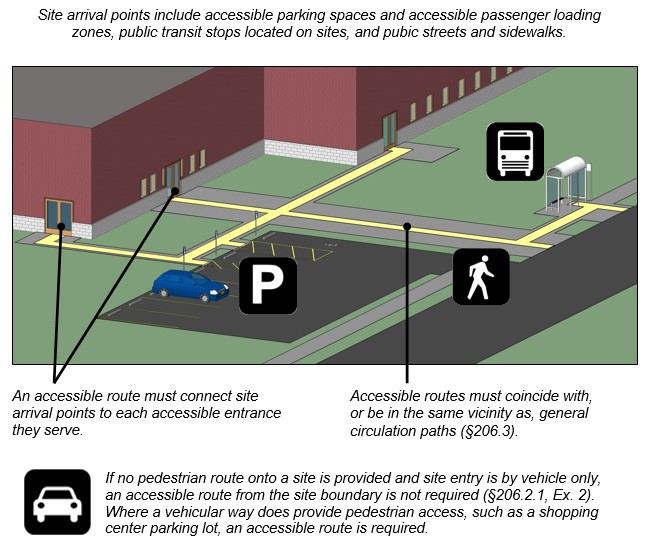
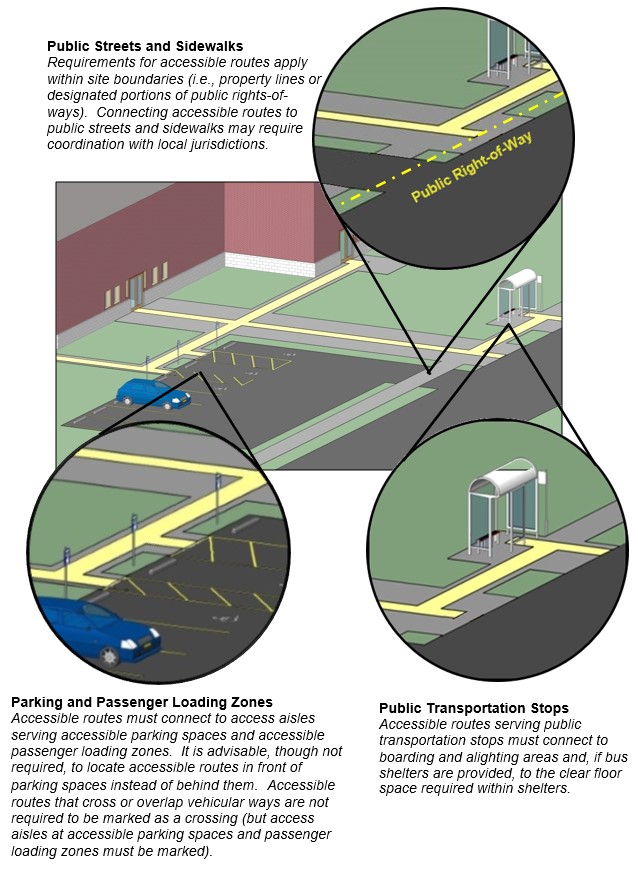
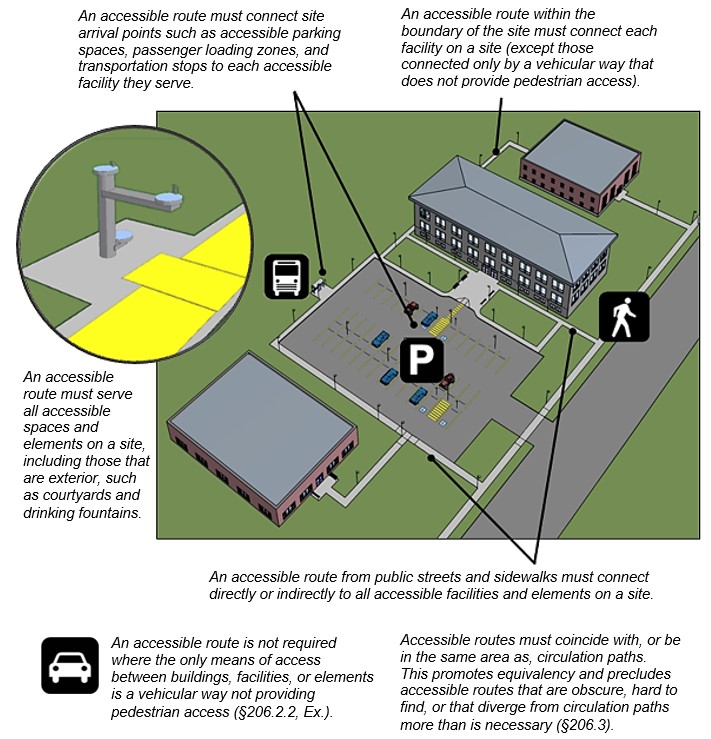
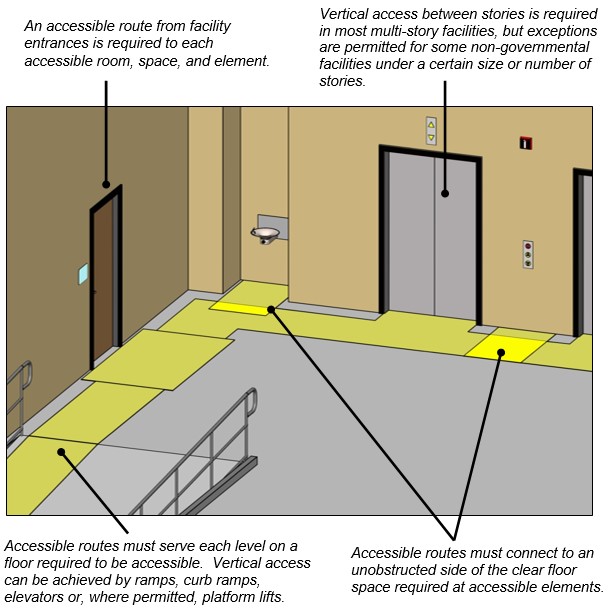

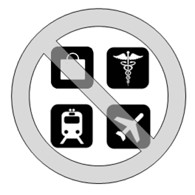




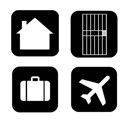
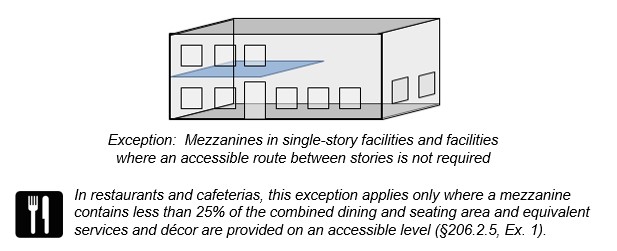
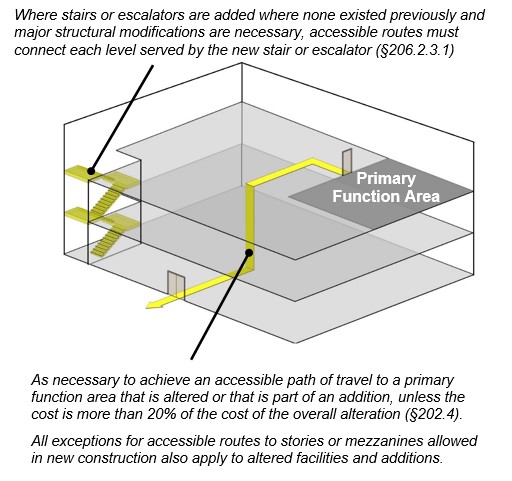
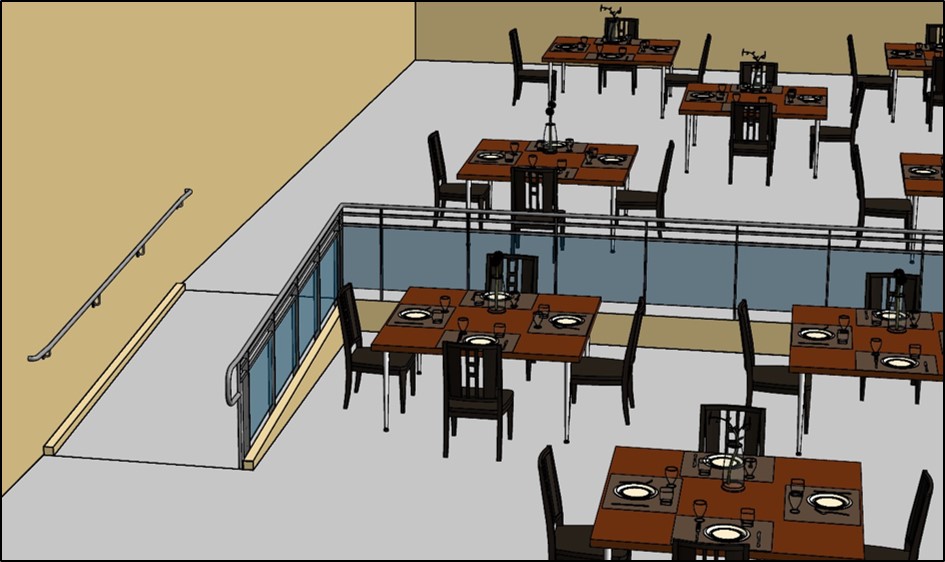


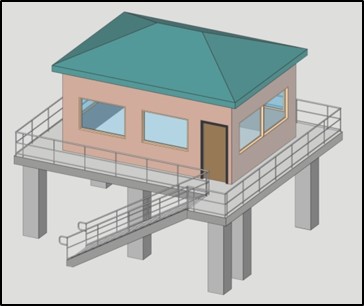
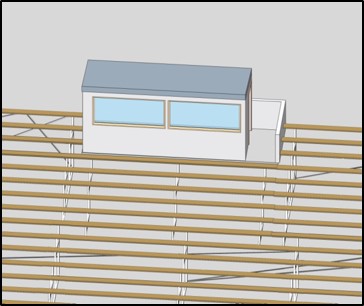
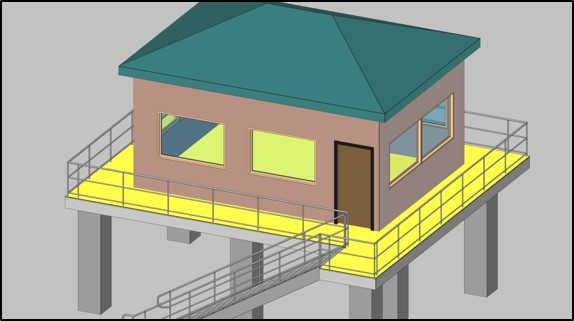
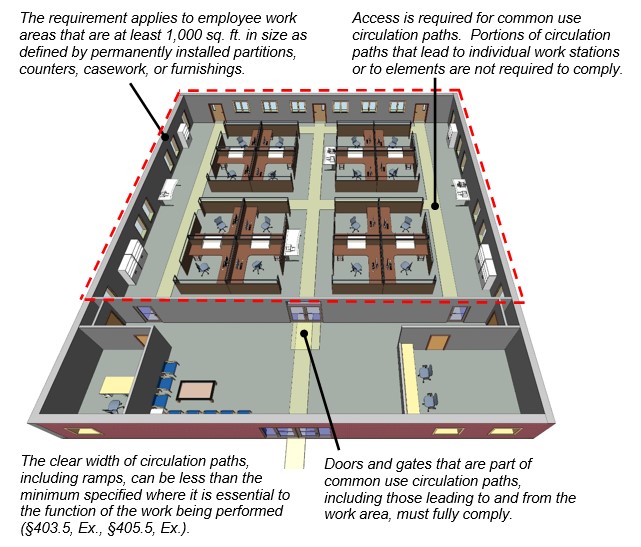


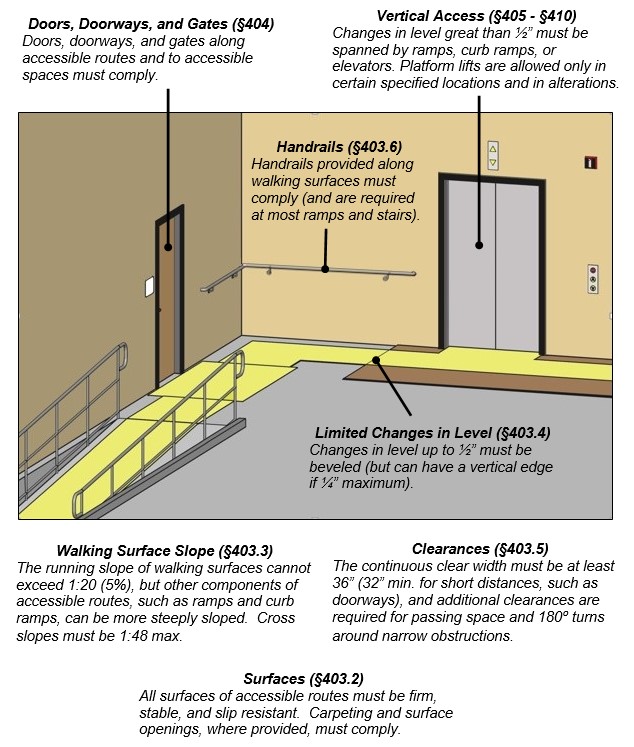
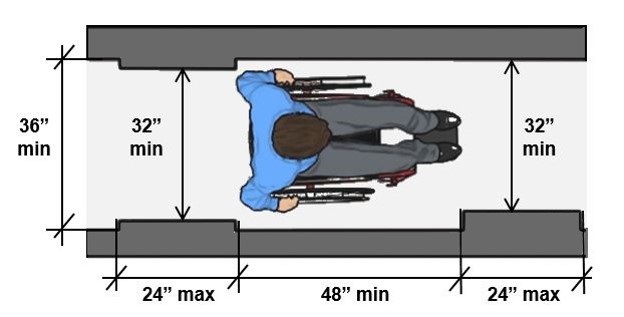
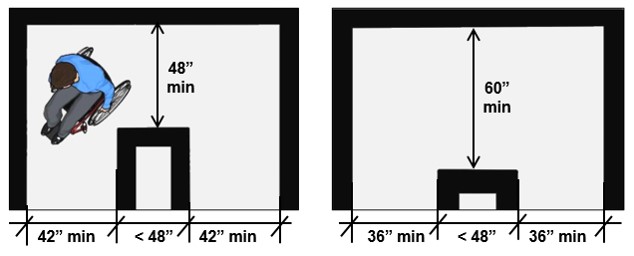
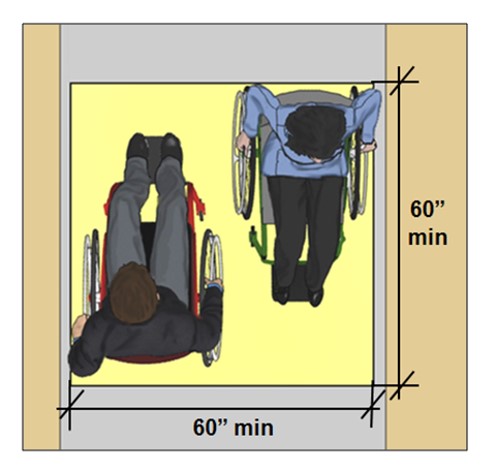
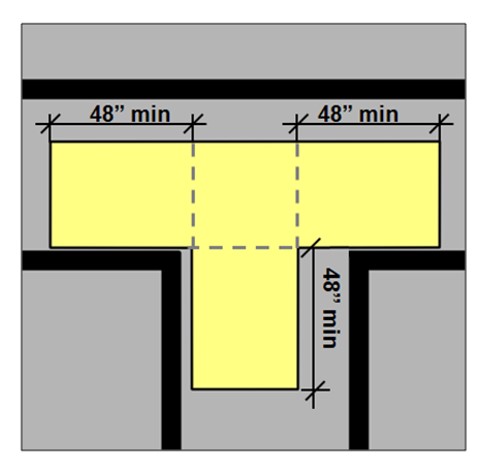
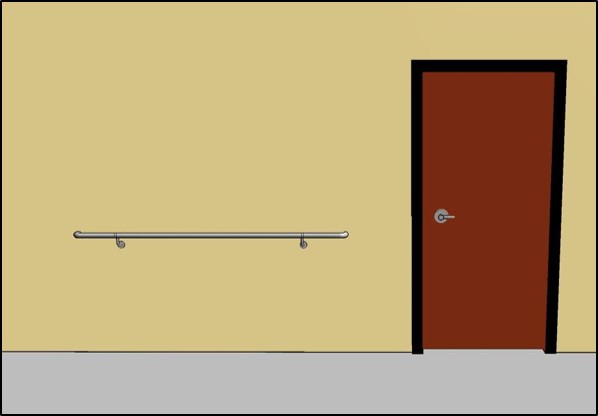
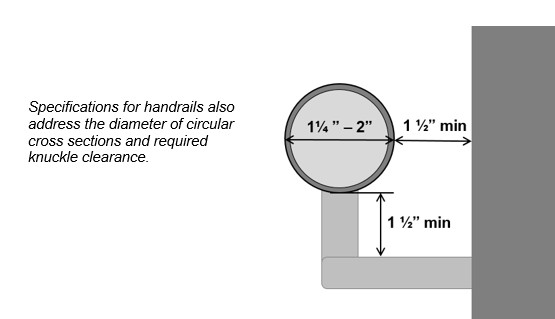
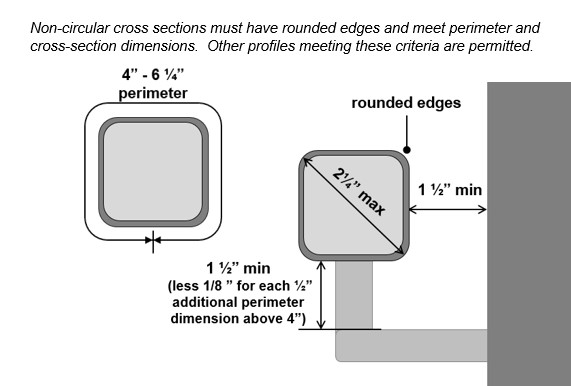

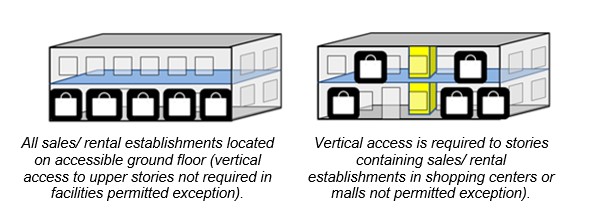

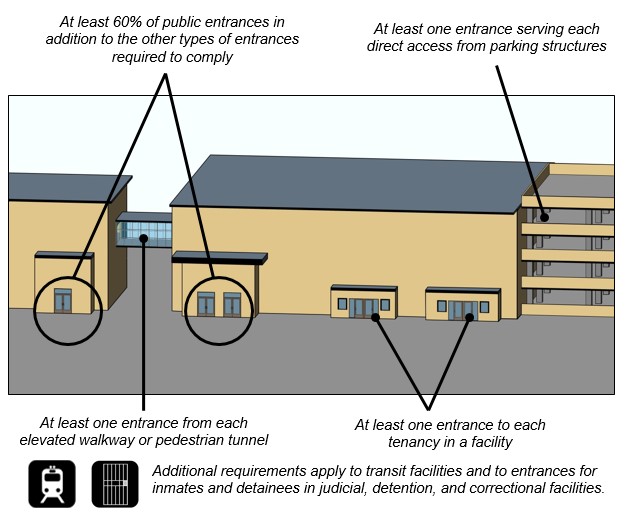

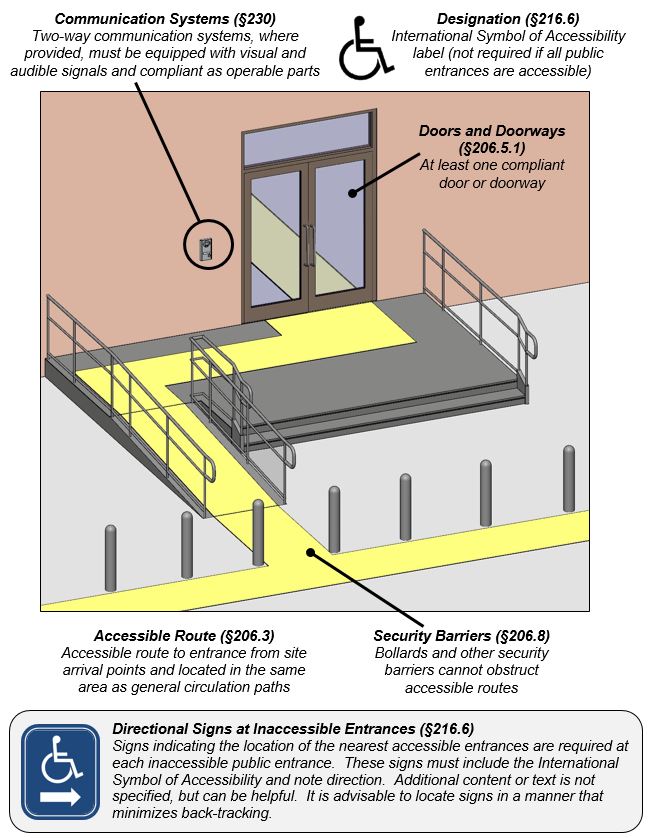
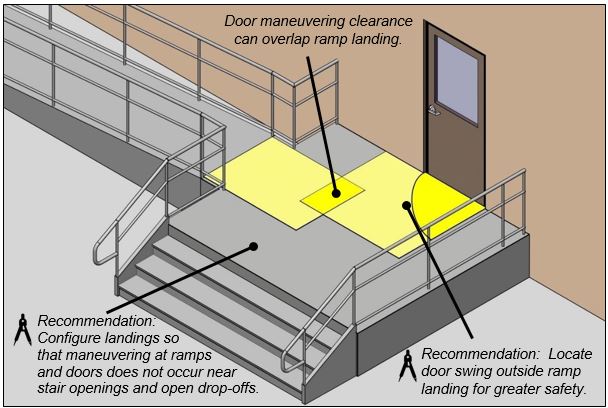
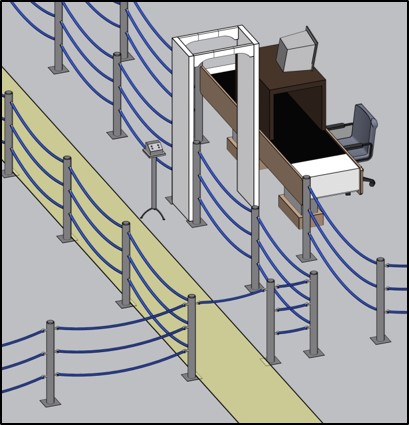
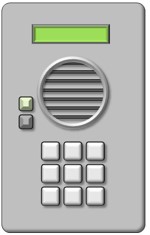
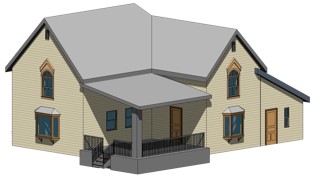
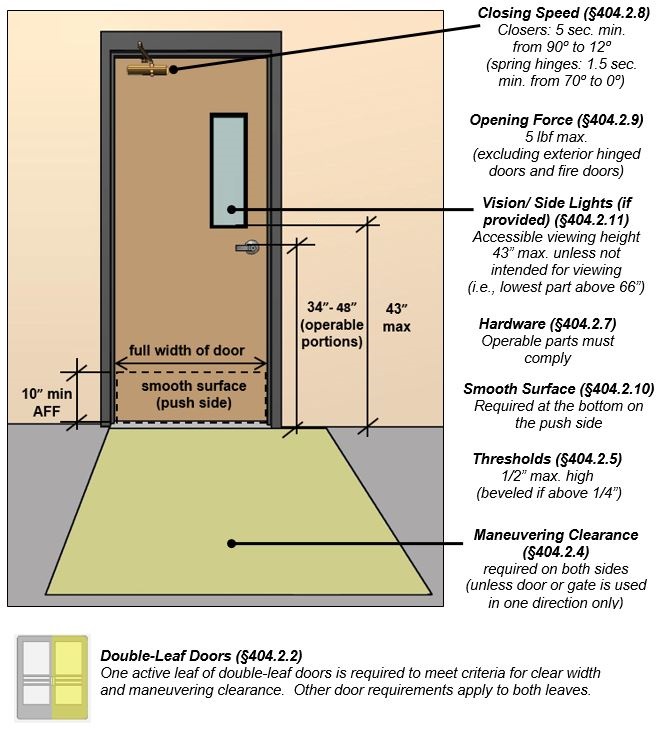
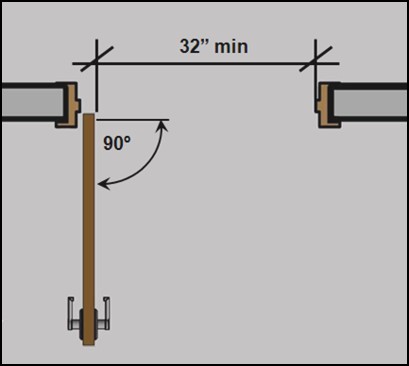
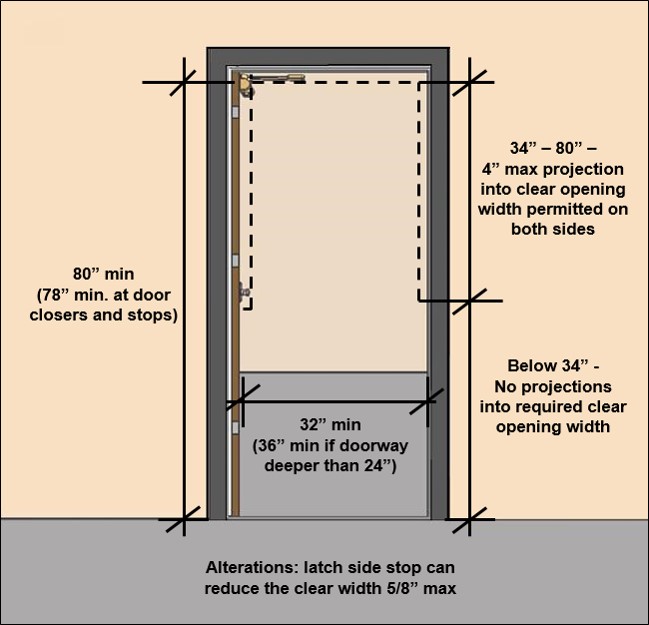
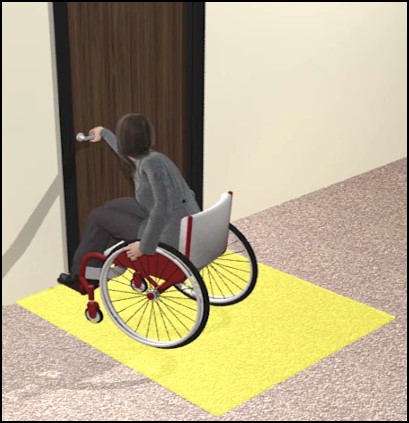
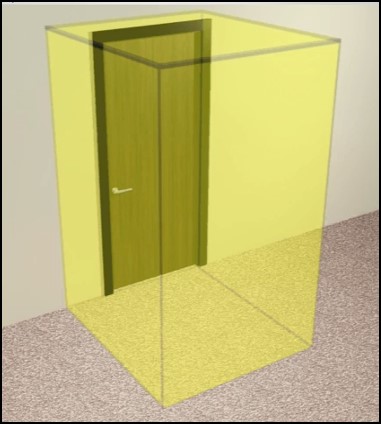
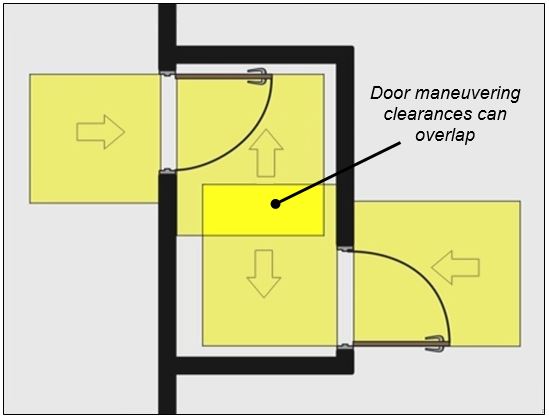

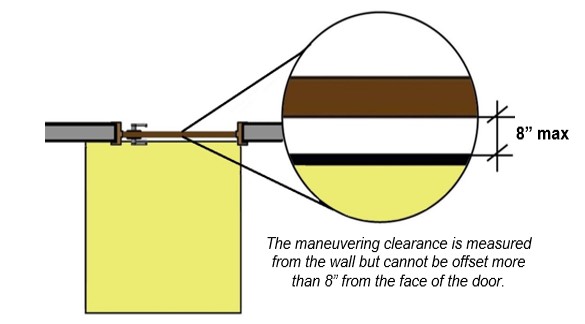
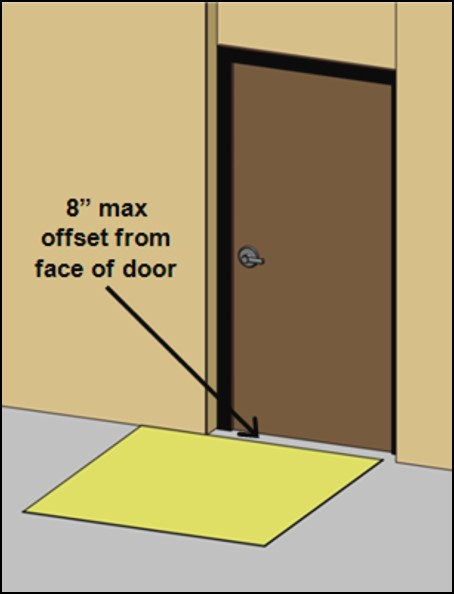
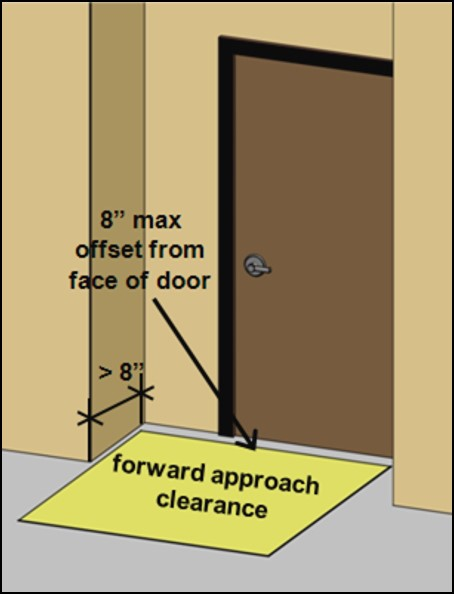
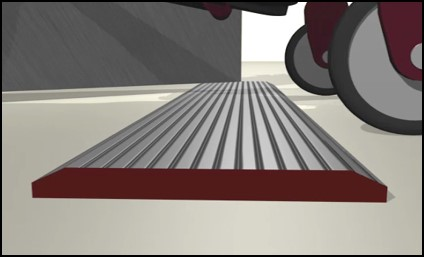
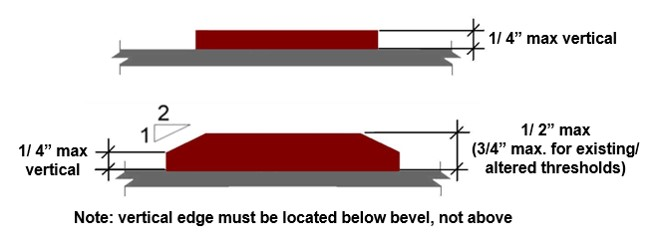
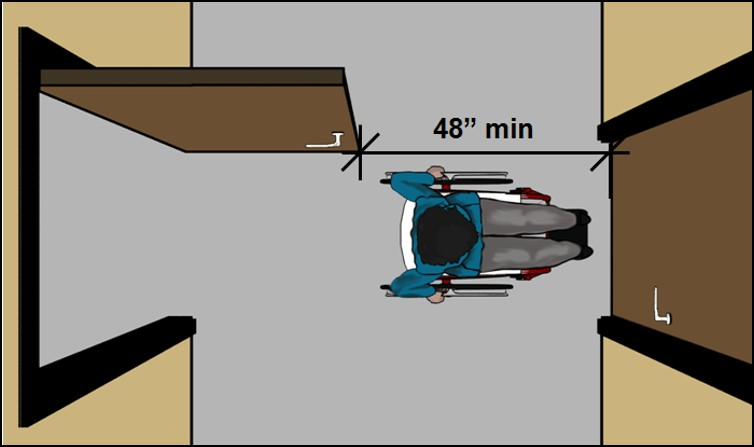

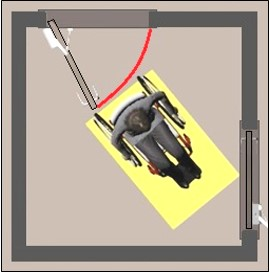
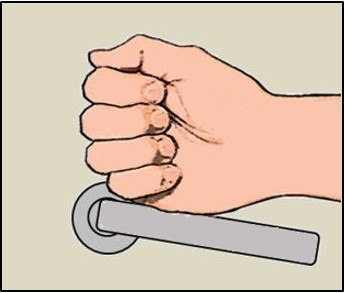

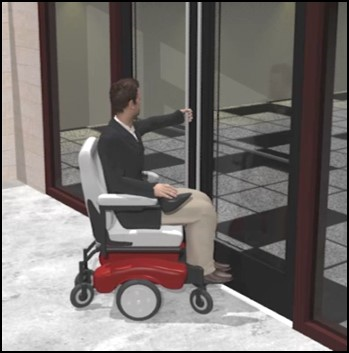

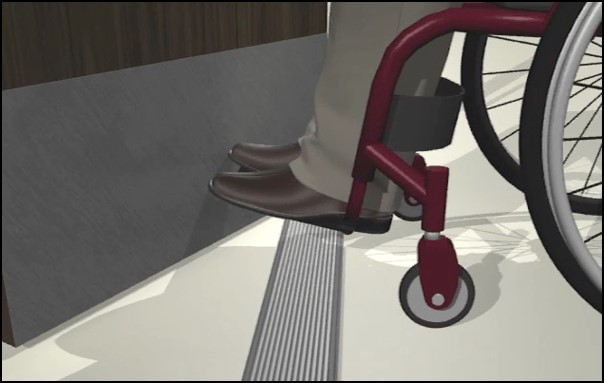
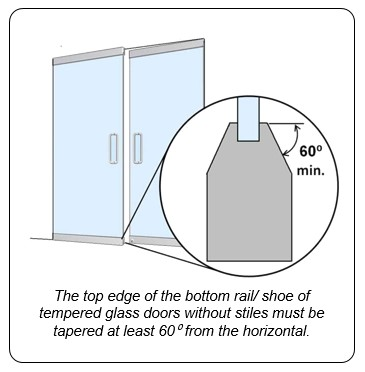



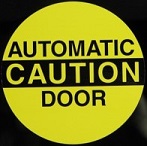
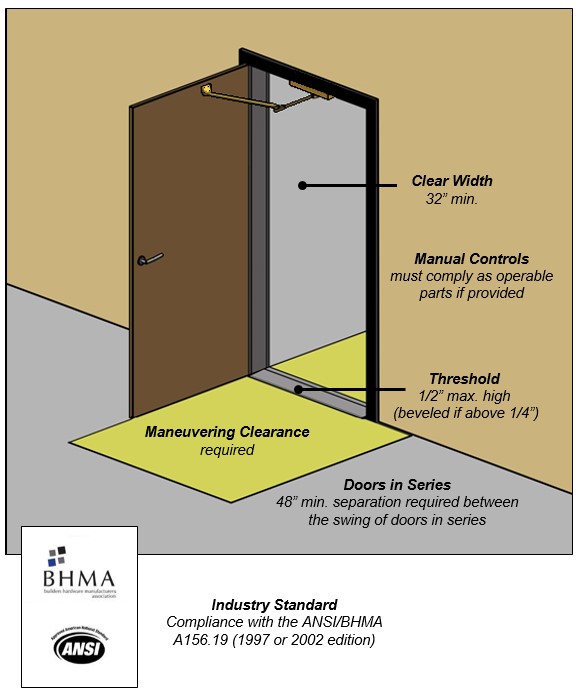
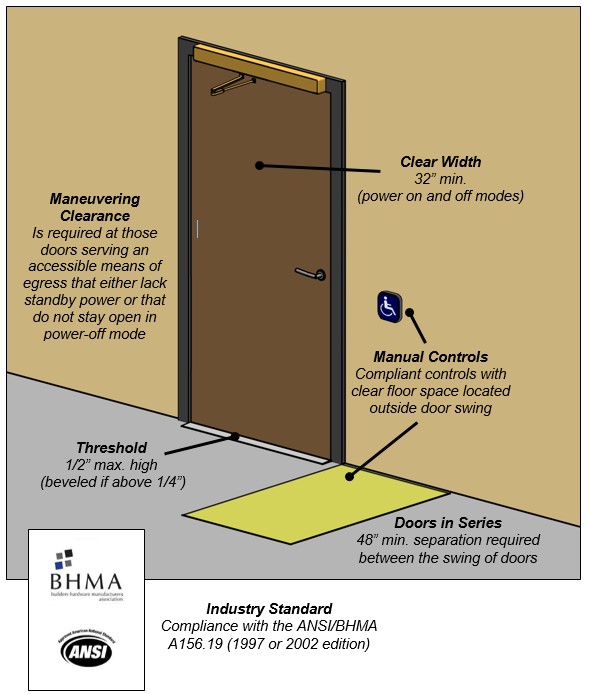
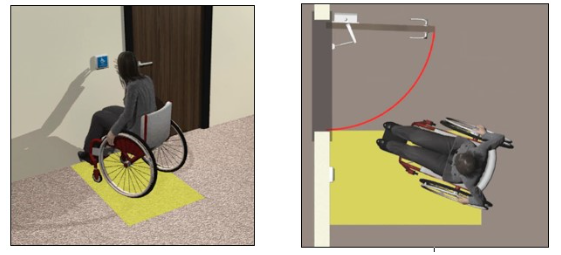
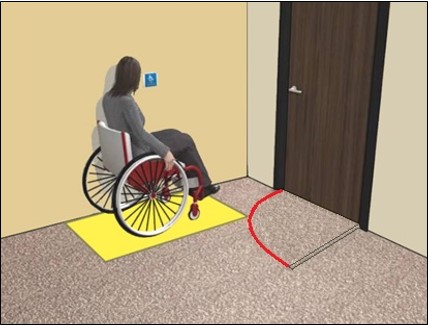

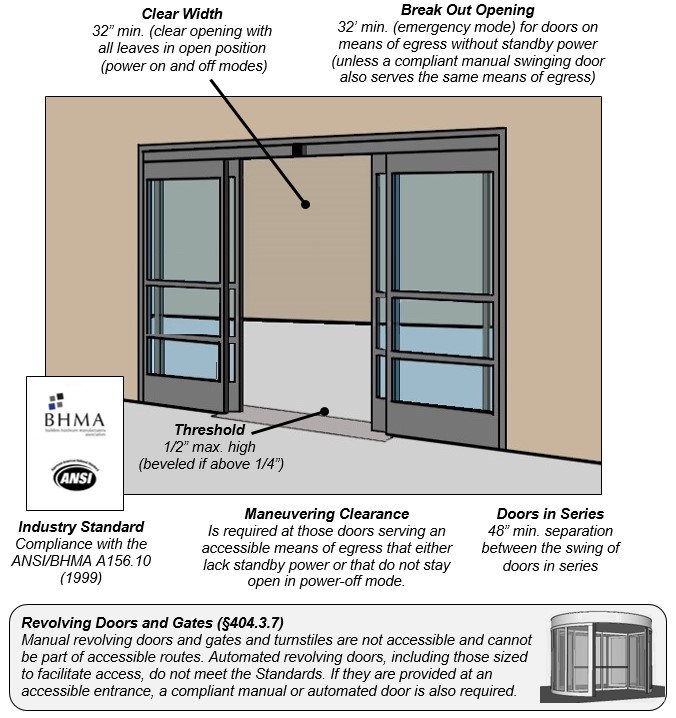

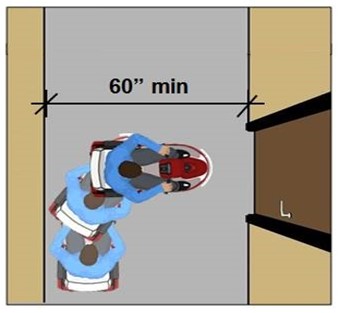
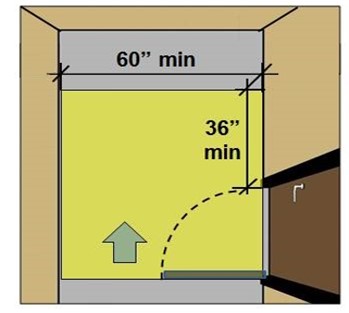

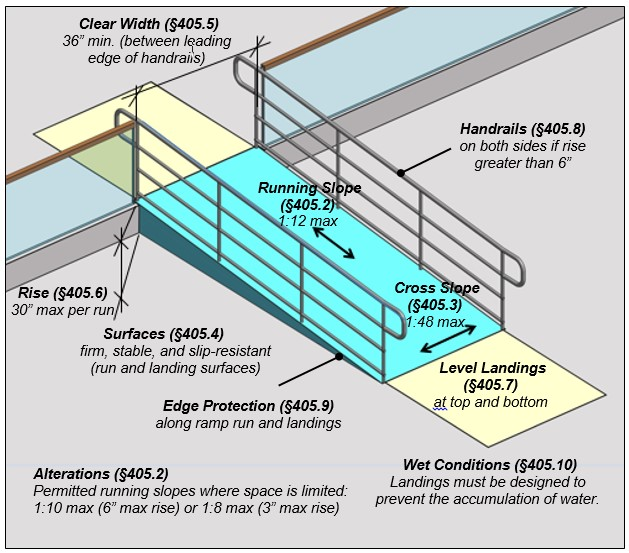


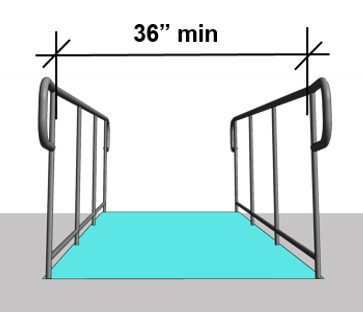
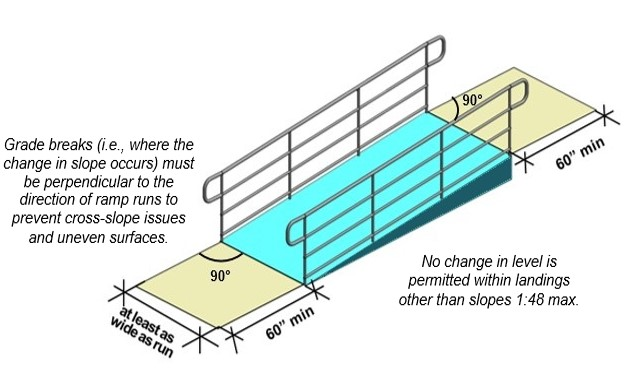
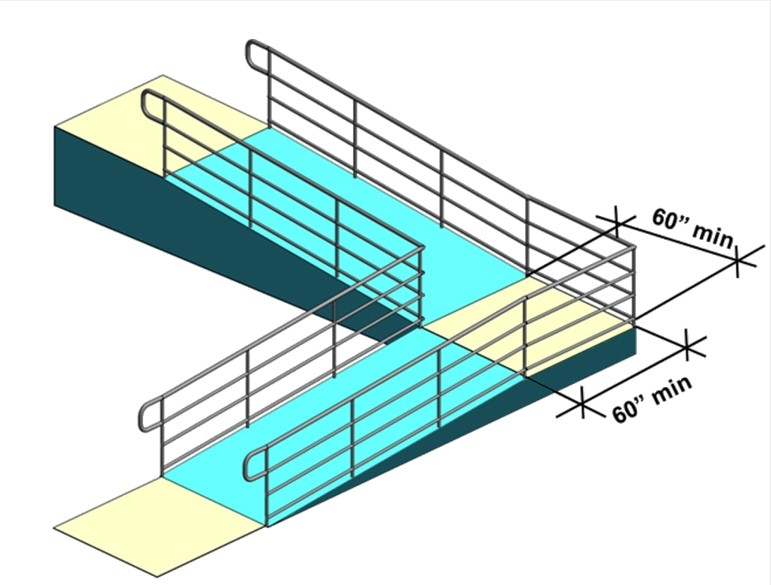
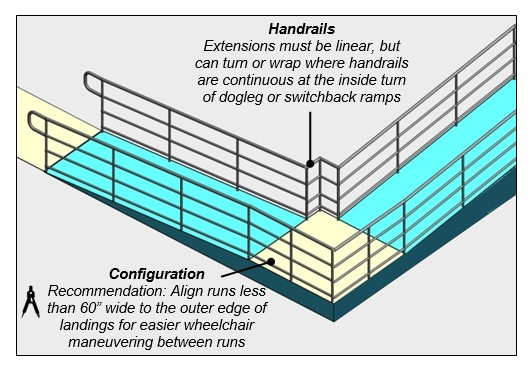
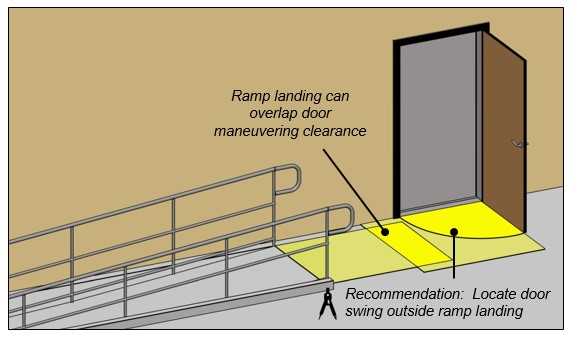
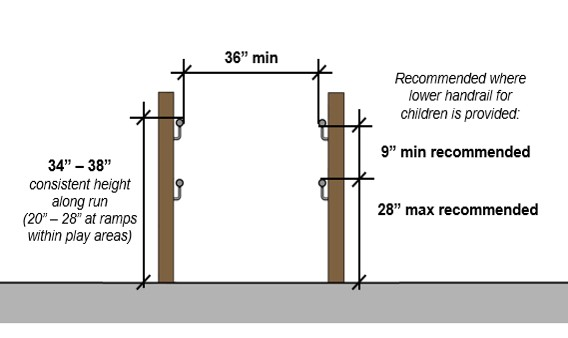
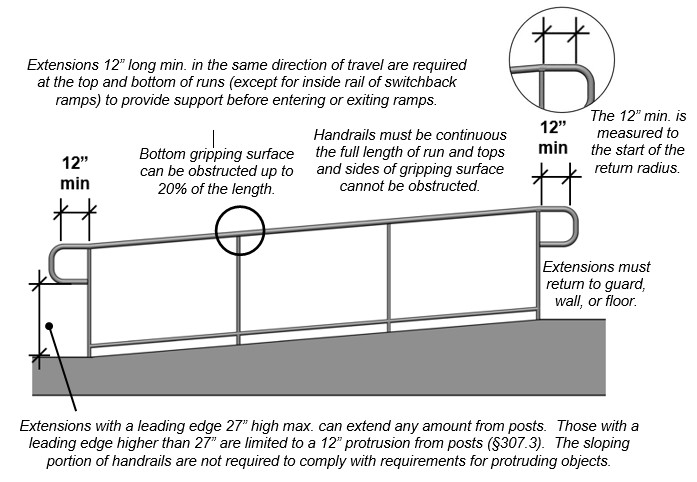
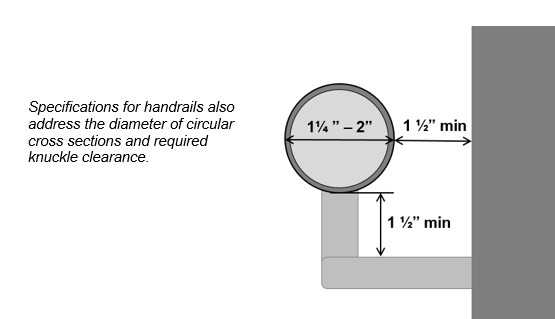
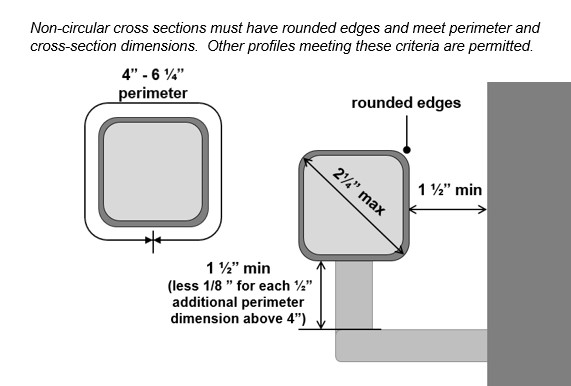

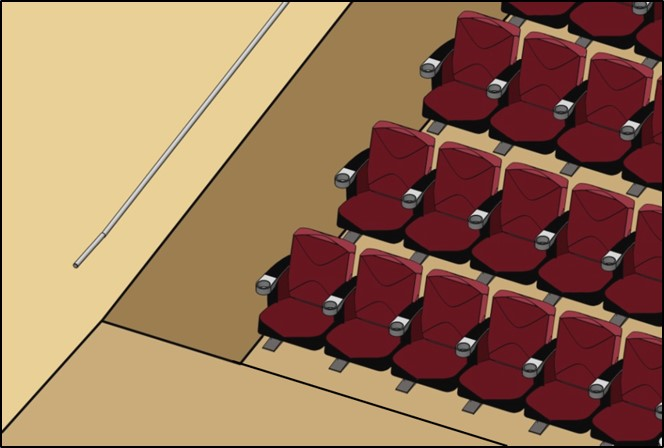

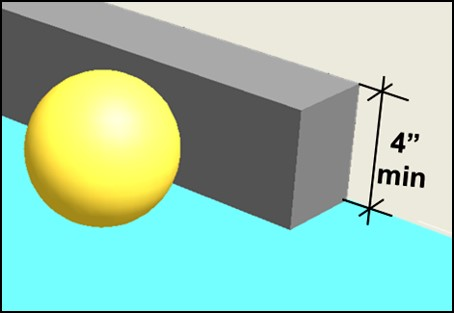
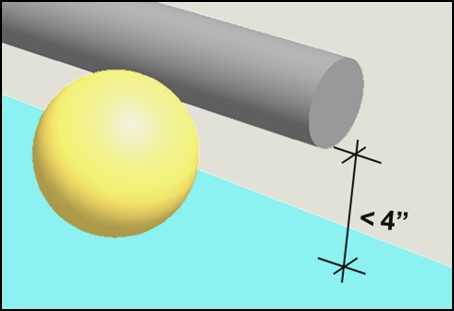
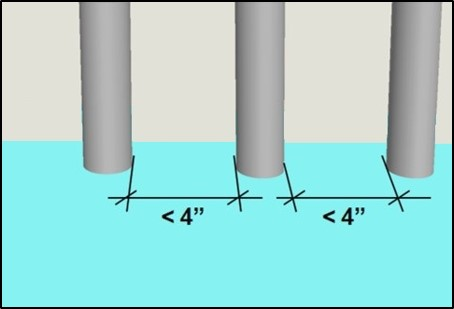
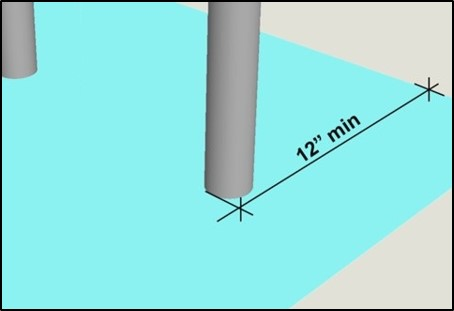
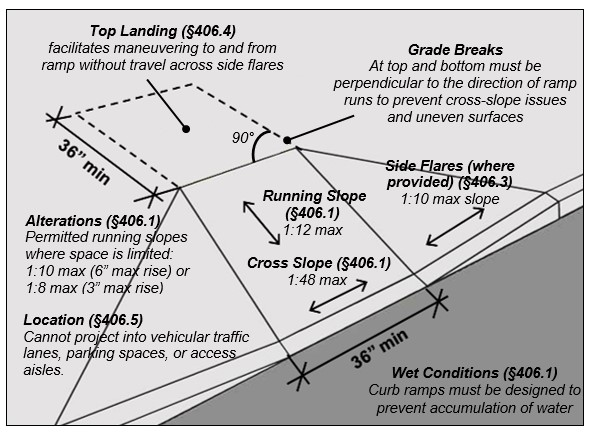

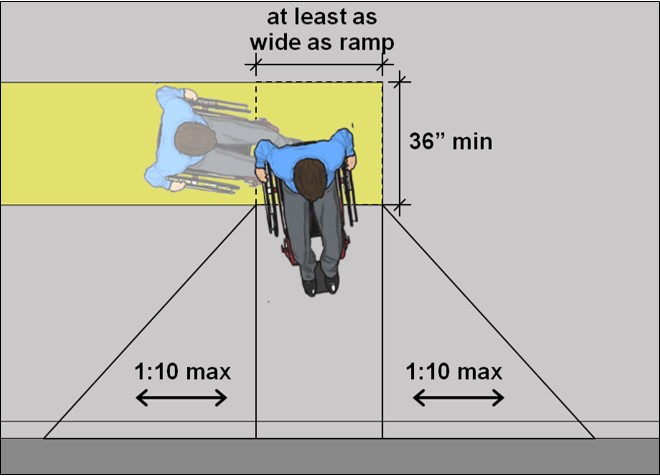
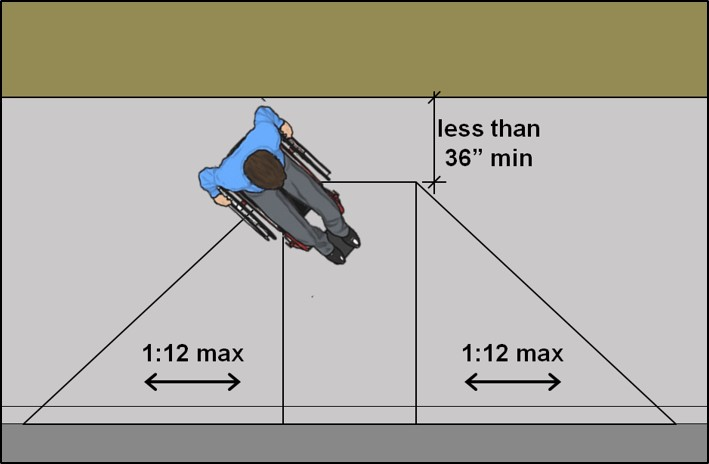
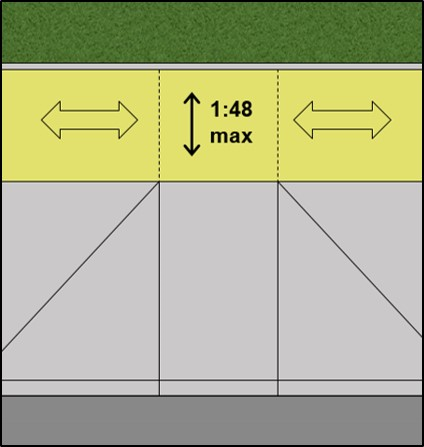
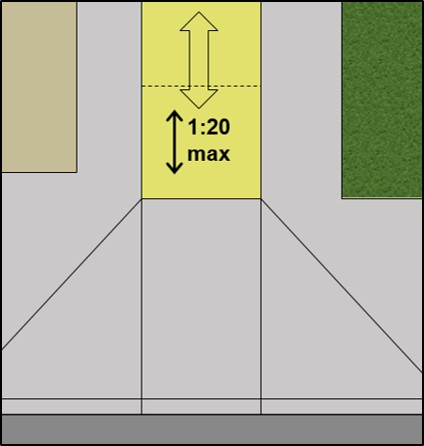
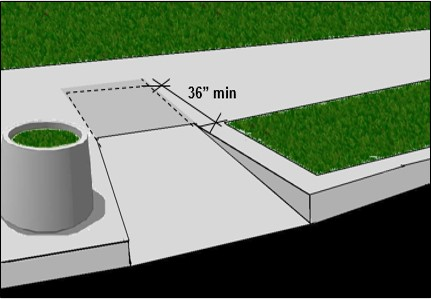

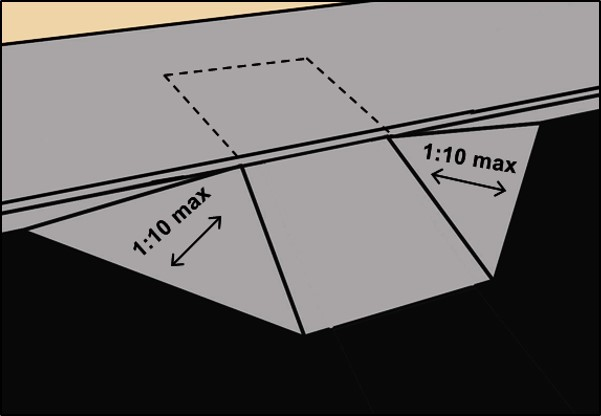

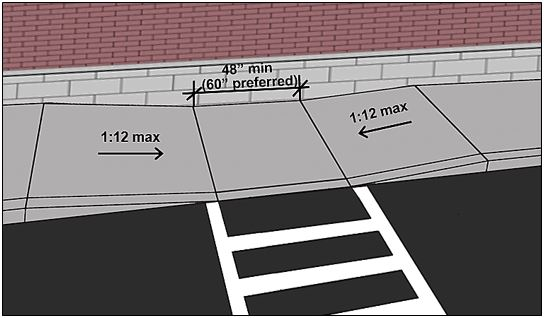
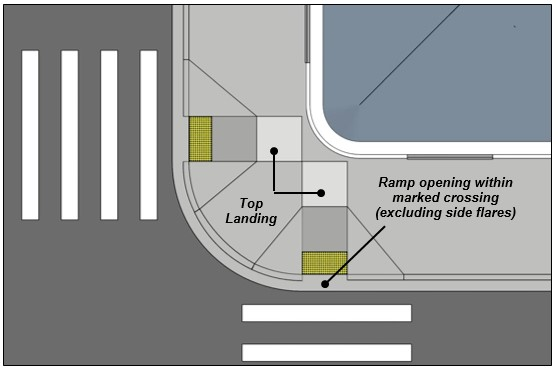
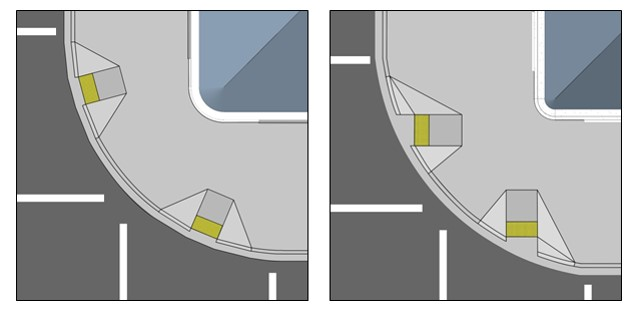
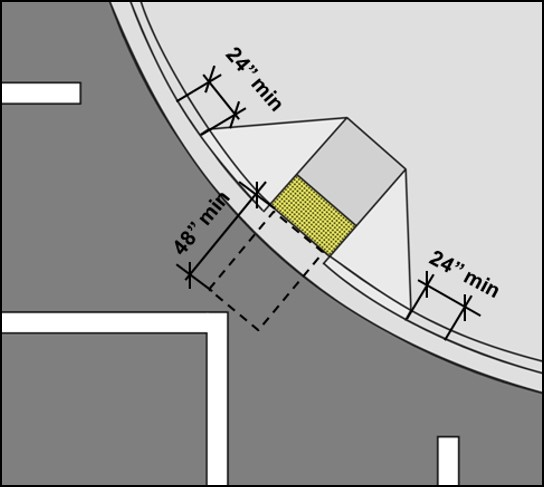

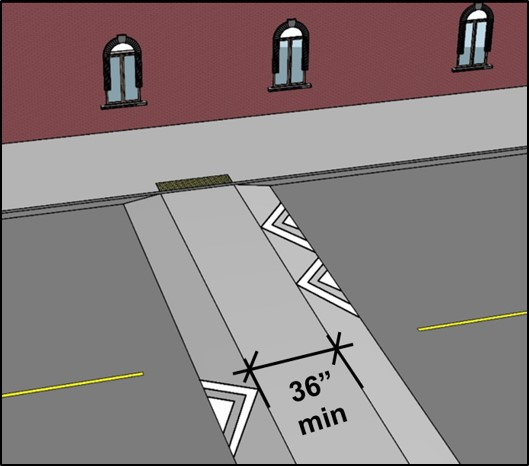
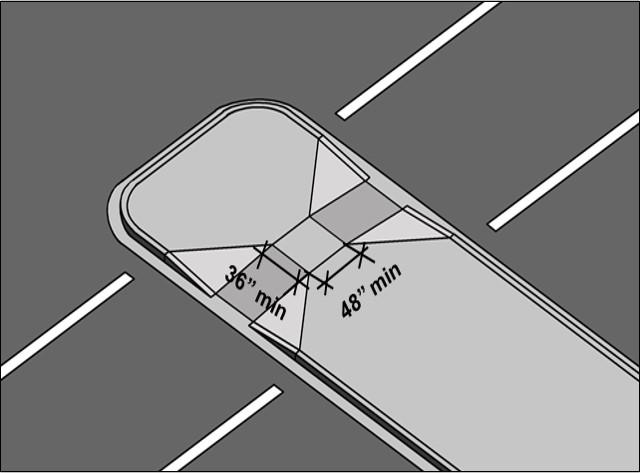
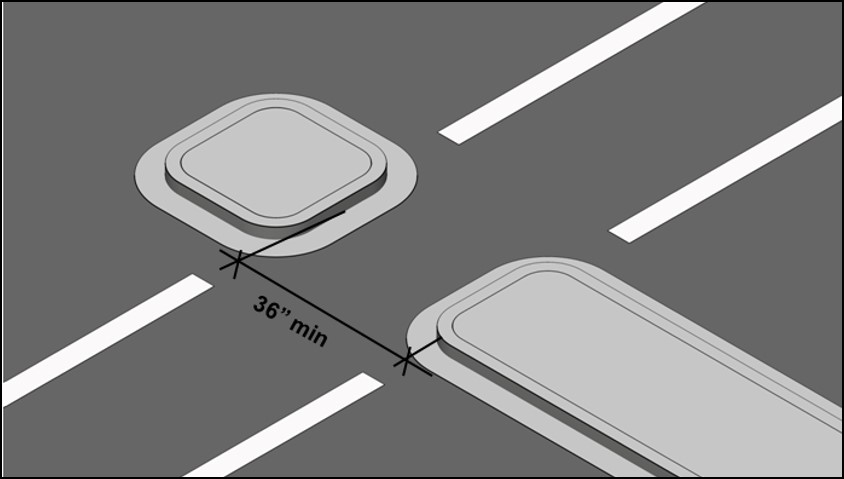

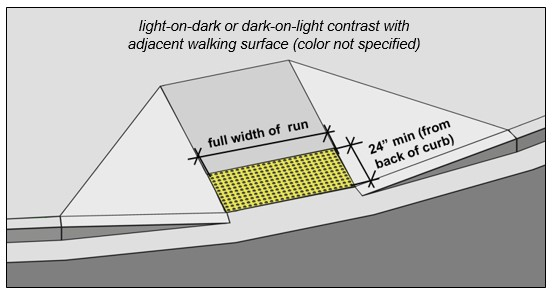
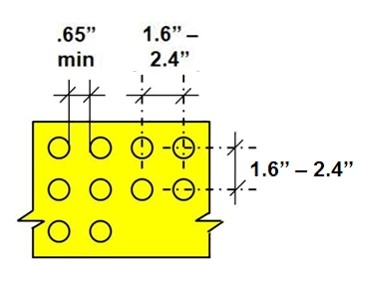
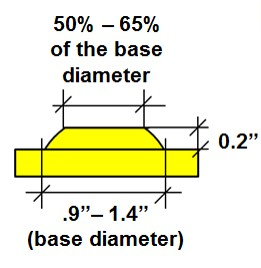


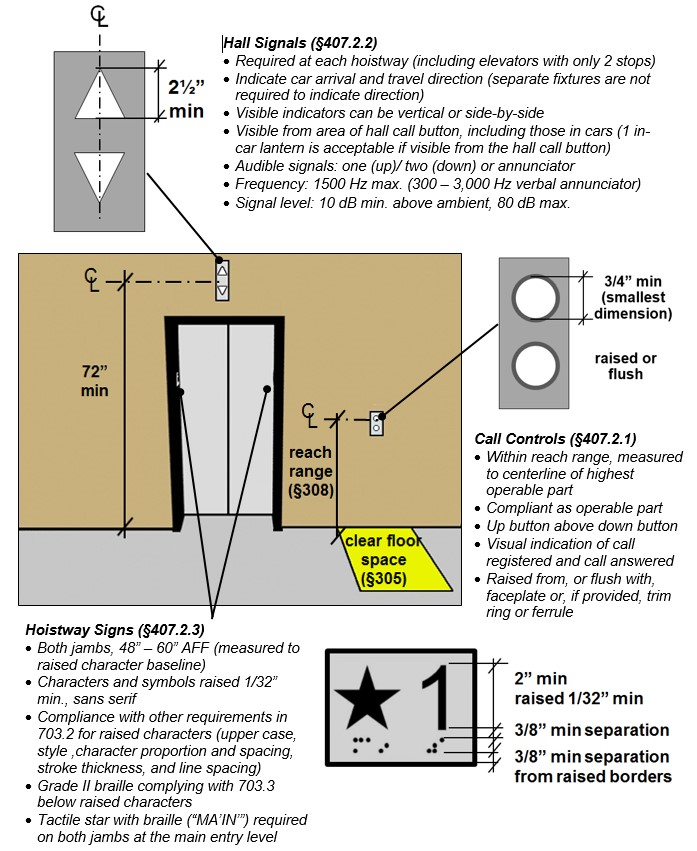
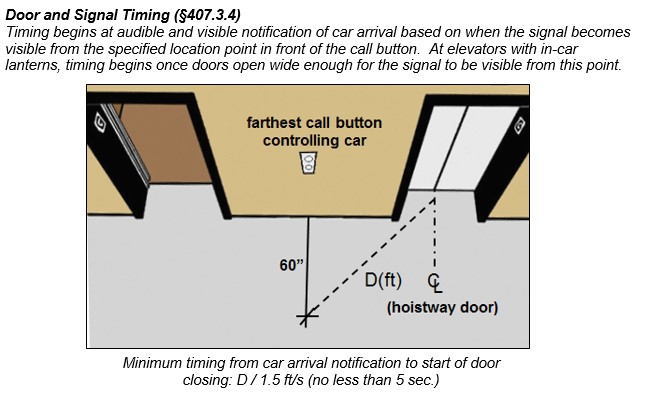
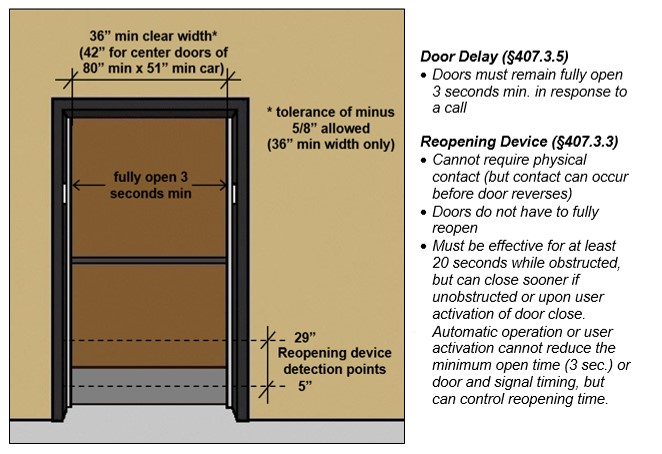
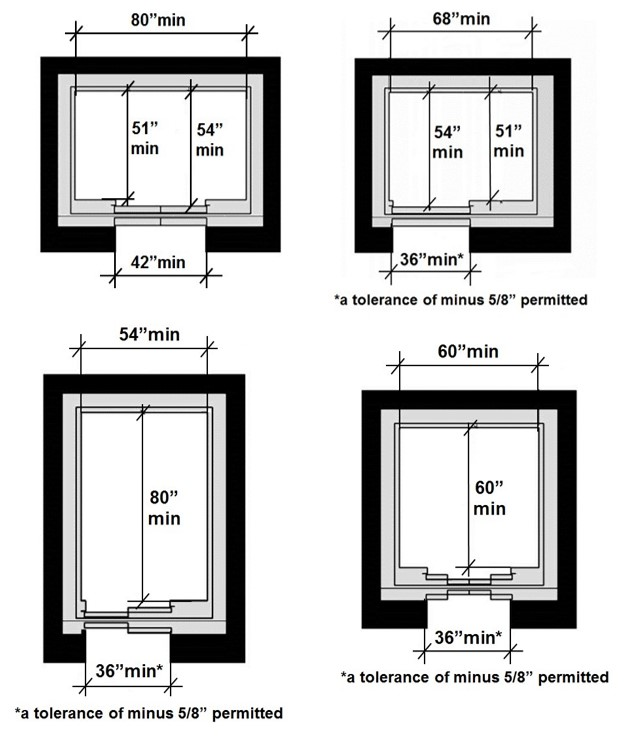
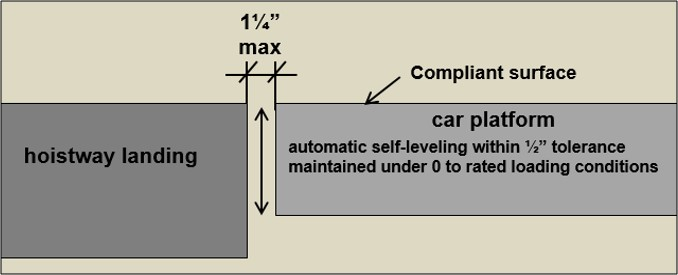
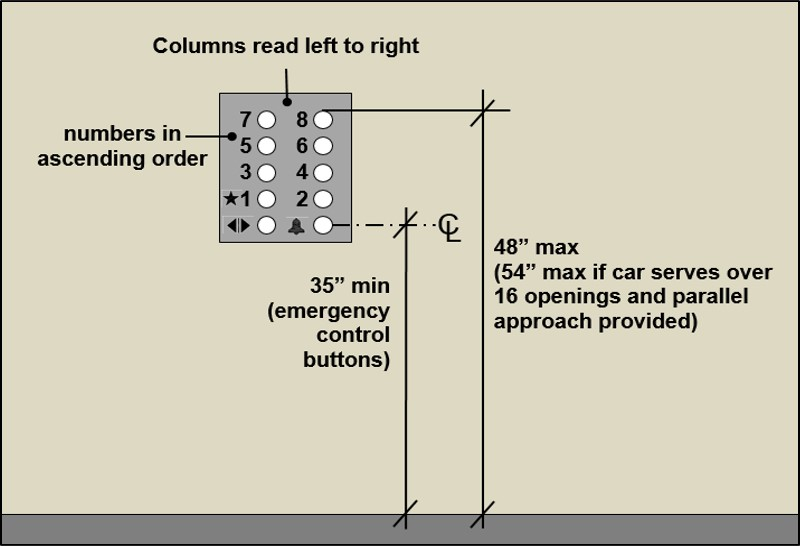
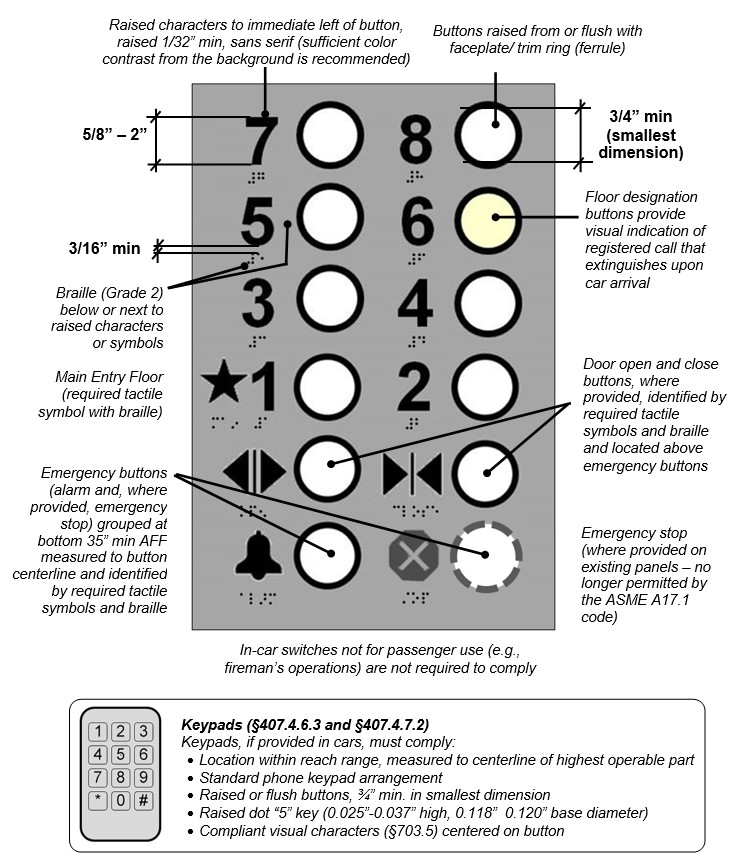
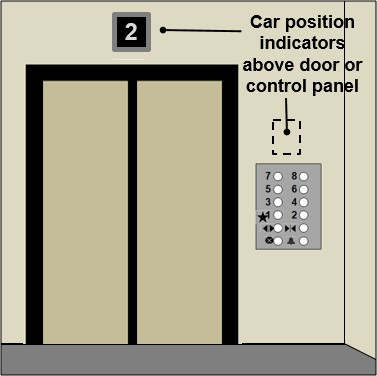
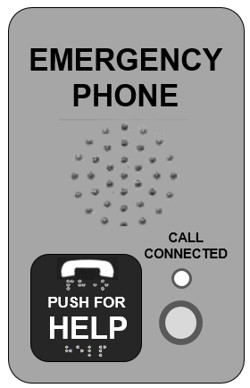
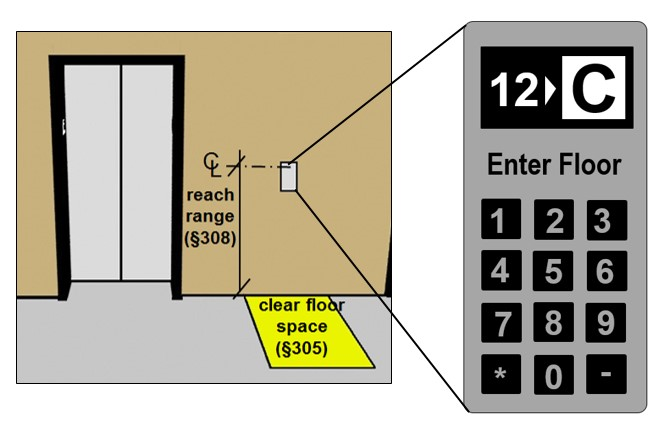
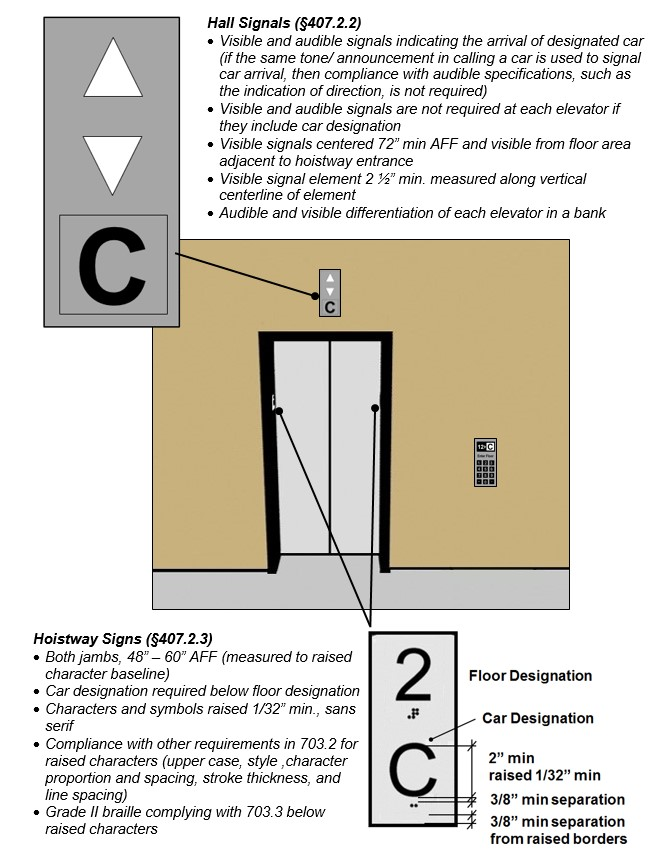

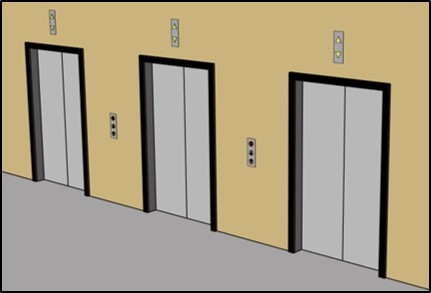
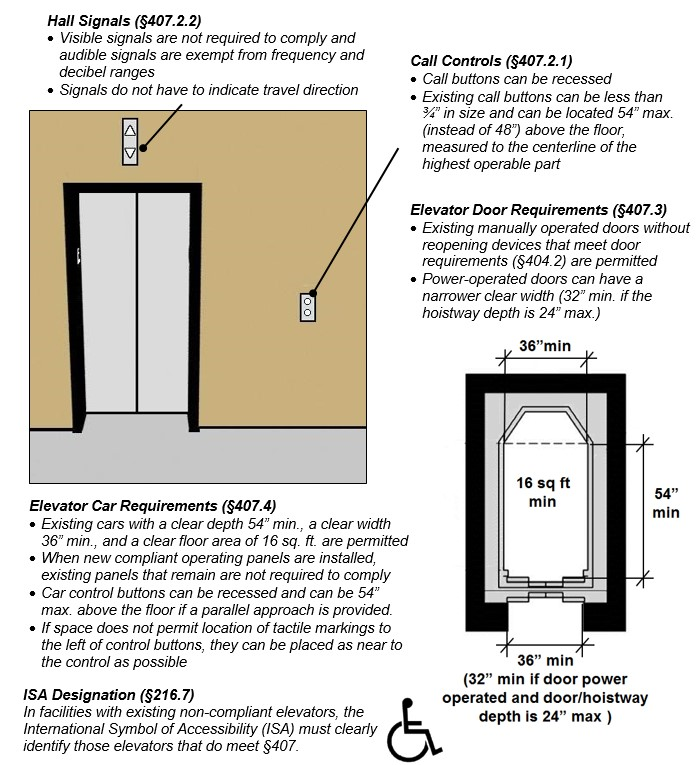

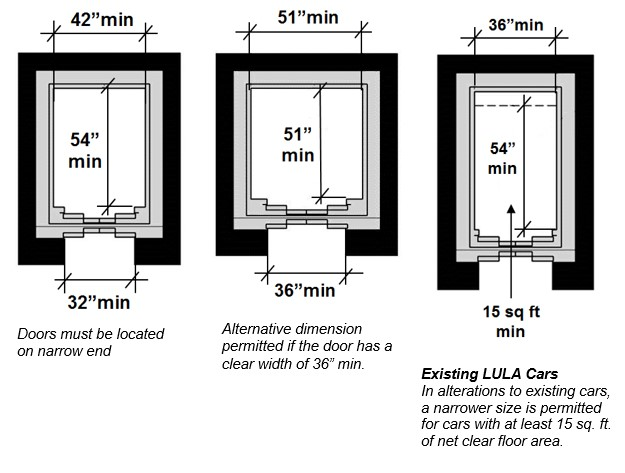
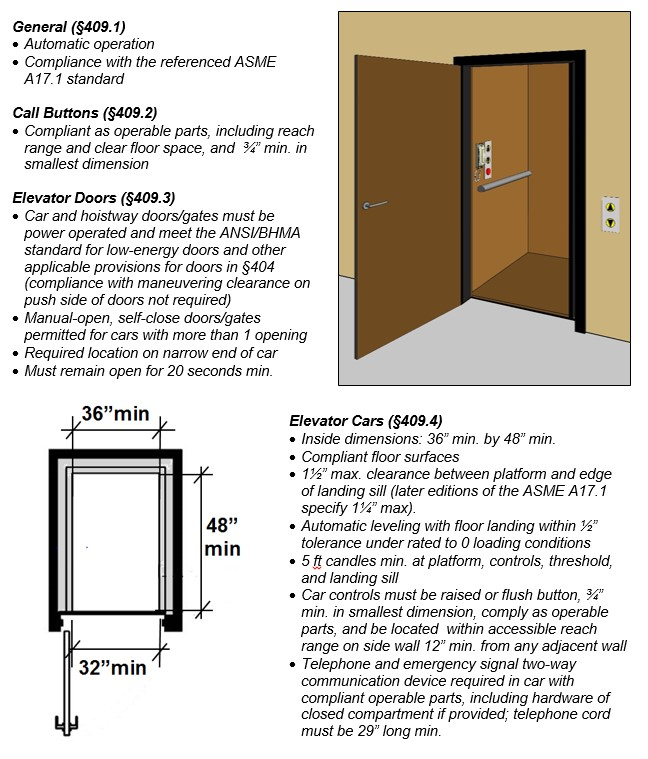

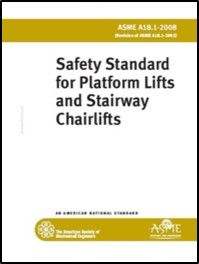
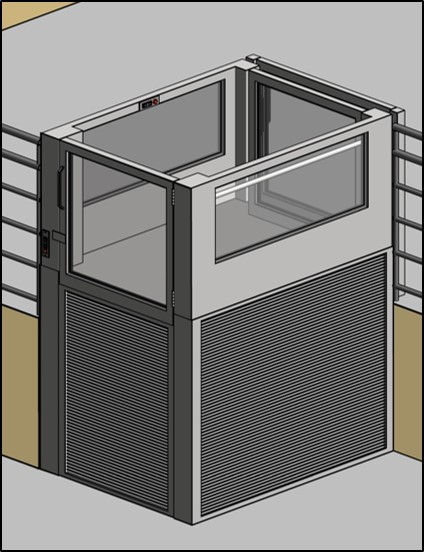
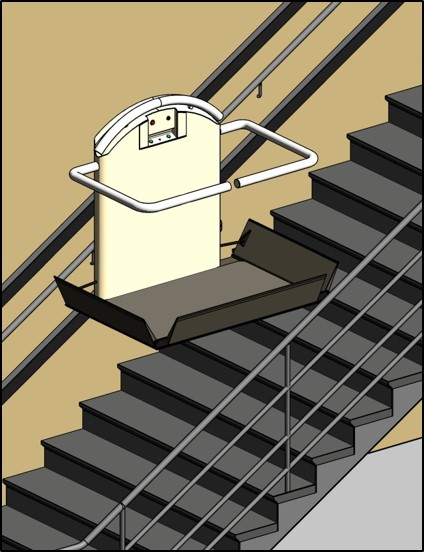
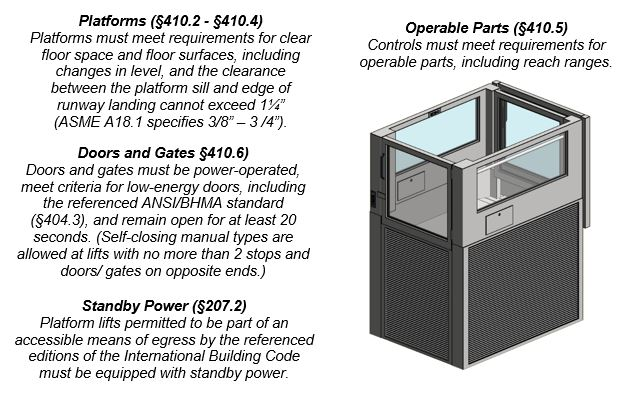
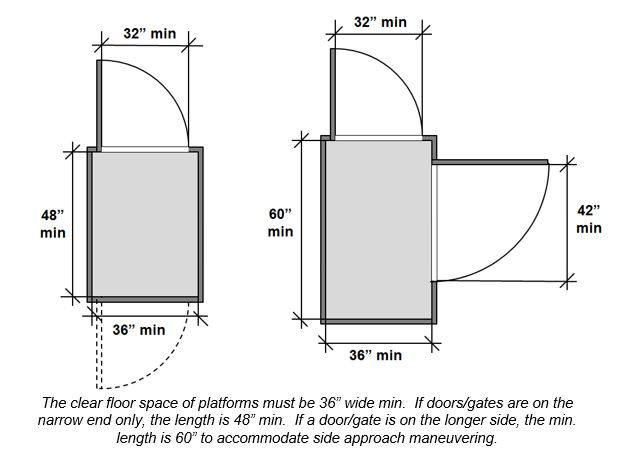




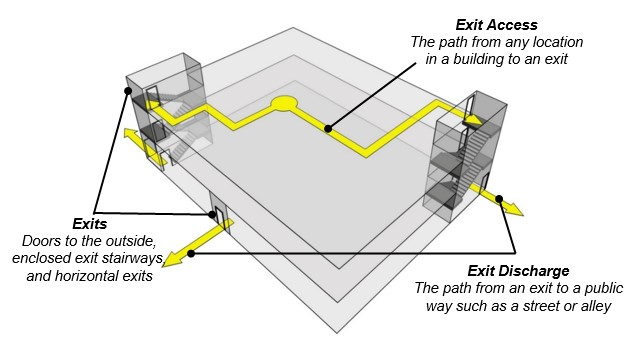
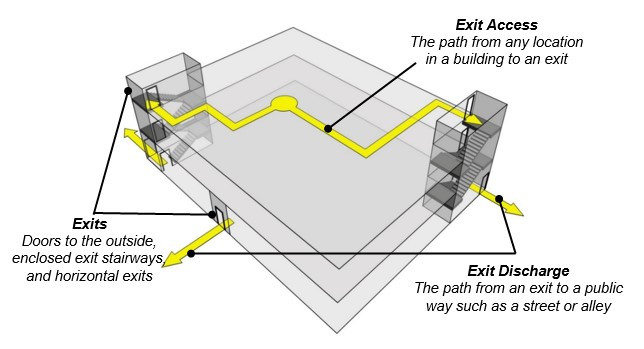
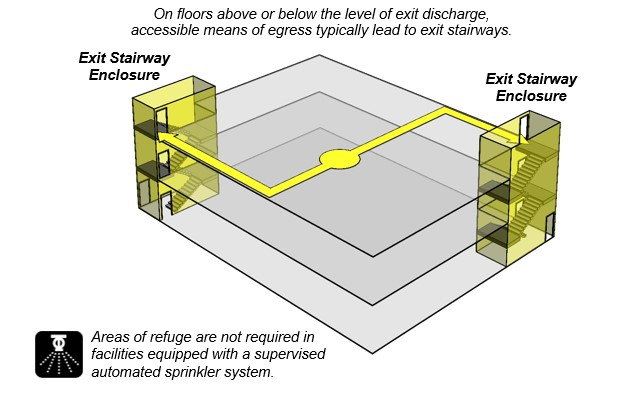
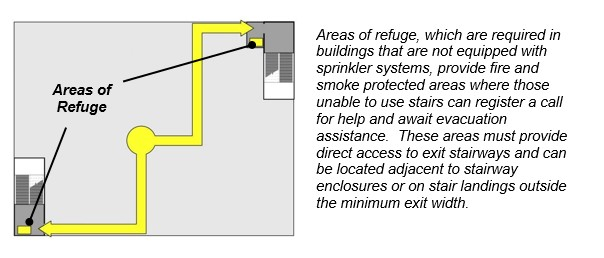

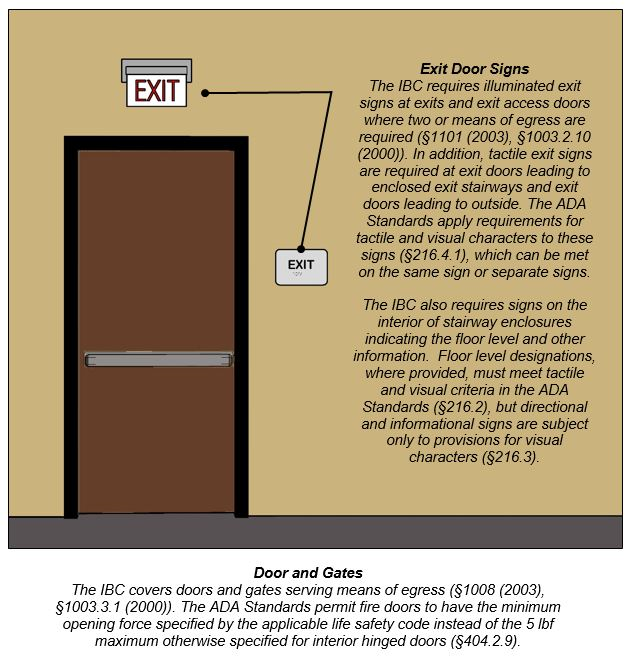

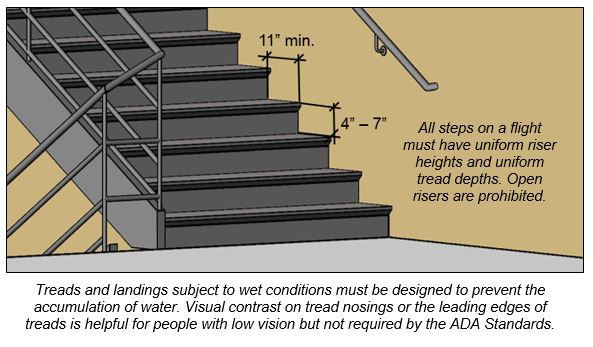
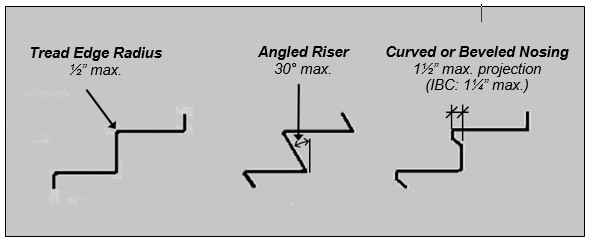
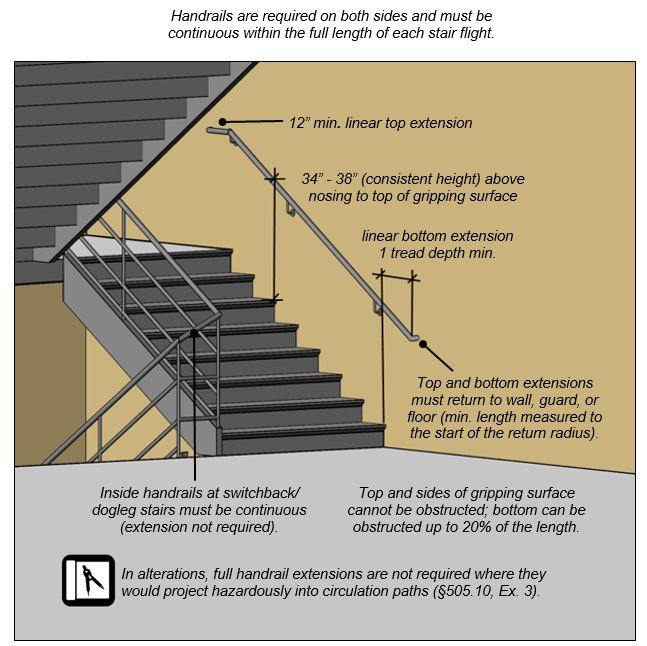
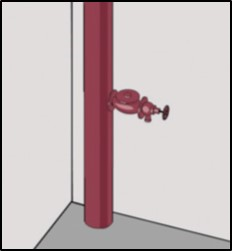
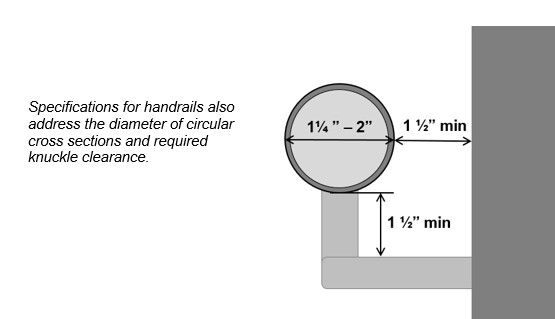
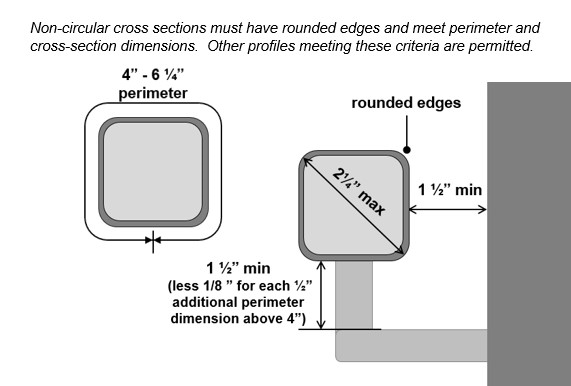
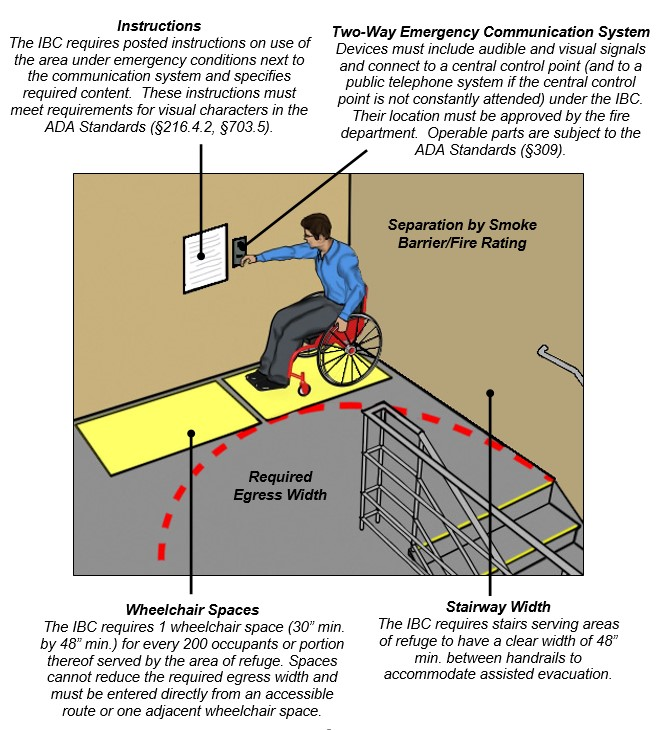
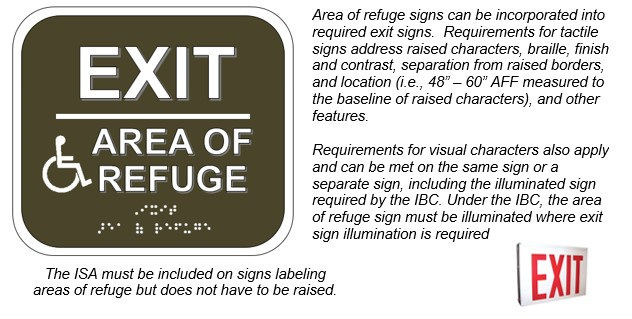
![Posted instructions next to area of refuge emergency communication device. Notes: Instructions [IBC §1007.6.4 (2003), §1003.2.13.5.4 (2000)] - The IBC requires signs in areas of refuge with two-way communication that provide: Instructions on how to use the communication system under emergency conditions; Directions to other means of egress; Indication that persons able to use the exit stairway are to do so as soon as possible, unless they are assisting others; Information on the planned availability of assistance in the use of stairs or supervised operation of elevators and how to summon such assistance; These signs must meet requirements in the ADA Standards for visual characters (§216.4.2).](/images/17048)

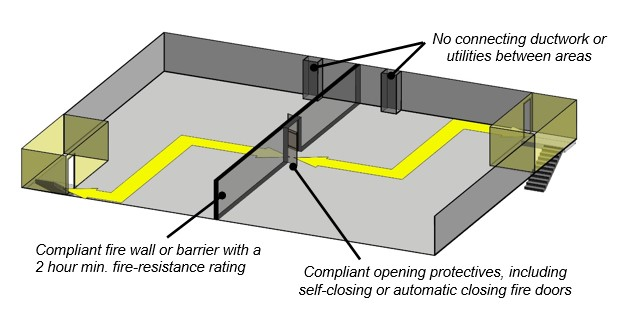
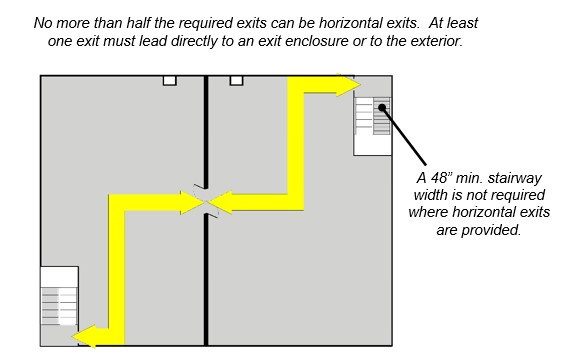
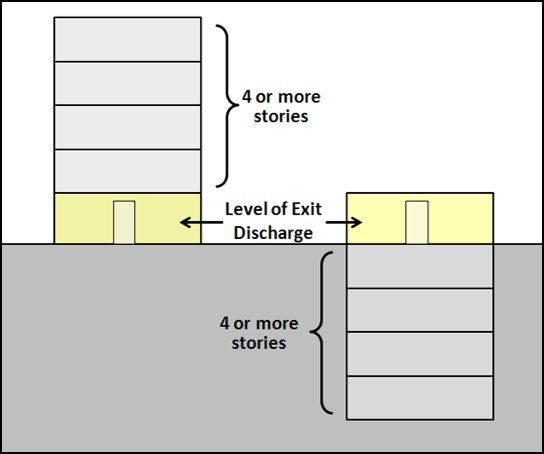
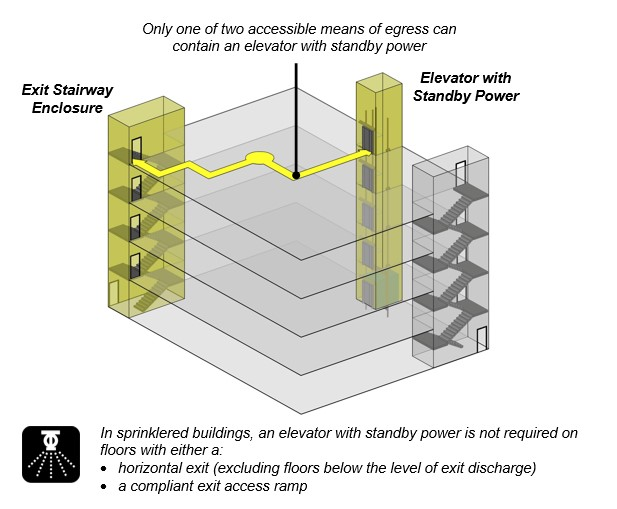
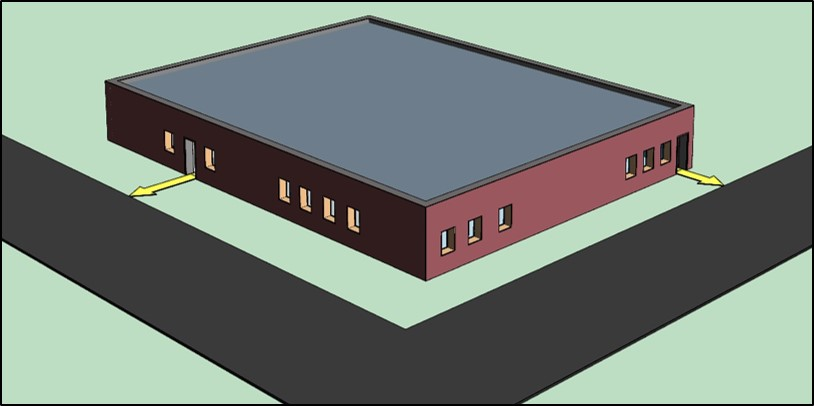
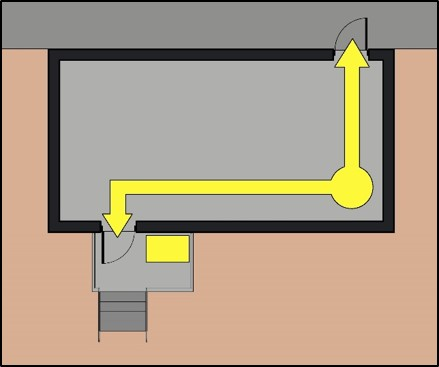
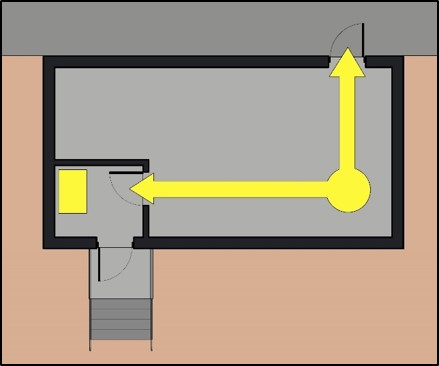
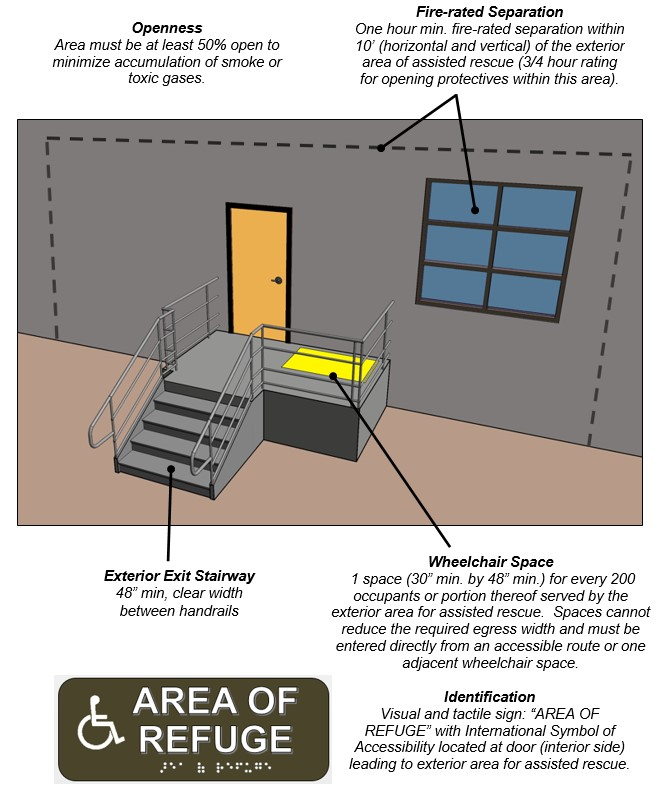

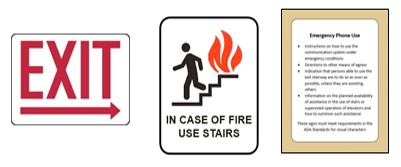
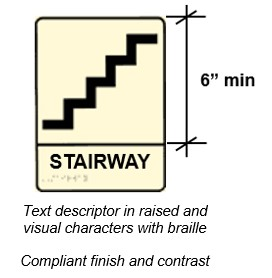

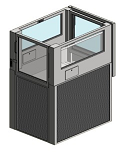
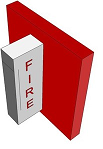
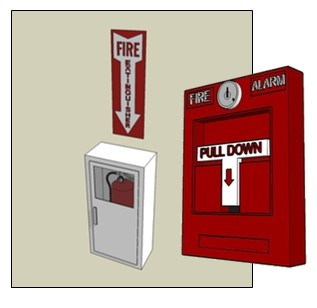
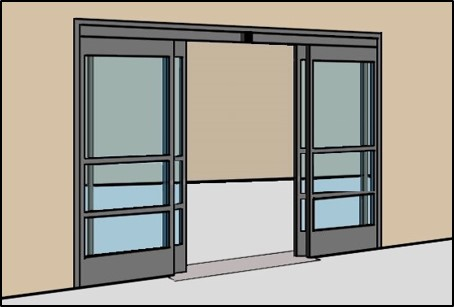

User Comments/Questions
Add Comment/Question